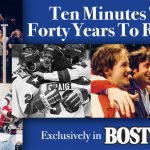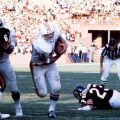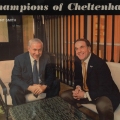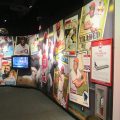Entrepreneur Stories

Foodie Hall in Cherry Hill

The best assignments a writer could ask for are the ones that include free food…but especially when that food is from recipes concocted by gourmet chefs. JerseyMan sent me to cover the opening of FoodieHall in Cherry Hill…a great place for outstanding grub. Check out the article from the magazine here.
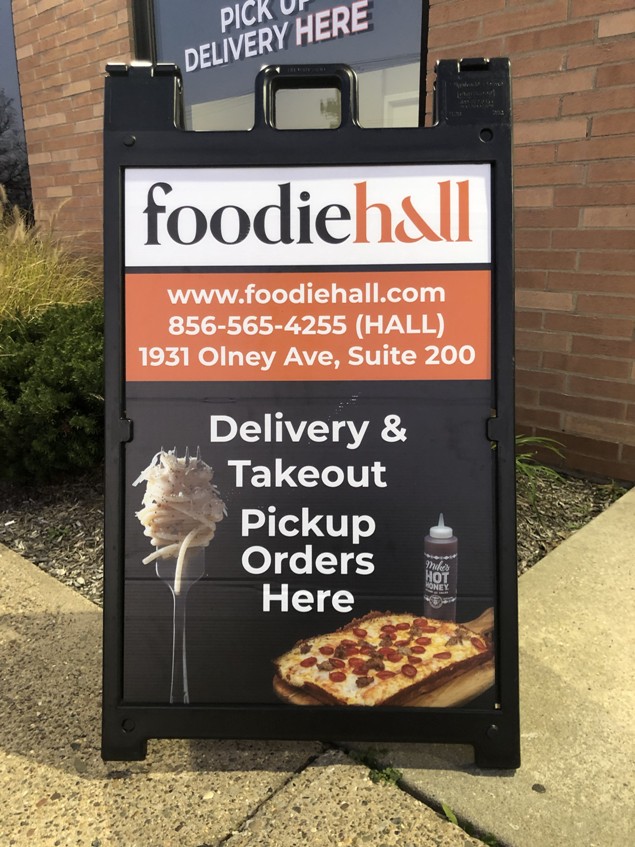
Hall of Food
The new Foodie Hall in Cherry Hill is a revolutionary concept – first rate food prepared specifically for takeout and delivery, while offering something for every taste.
For you JerseyMan readers and Legacy Club faithful, since membership has its perks, we’re about to share privileged information with you. If you’re on a plane or train, check that no one is looking over your shoulder, and that there are no surveillance cameras nearby. We’re entrusting you as someone with a need to know.
Here it is: You can now get a Geno’s cheesesteak in South Jersey.
Okay, maybe it doesn’t sound that momentous. Tony Luke’s, Primo, DiNic’s and other iconic Philly sandwich shops have all opened outposts across the Delaware, sparing their enthusiasts in our neck of the woods considerable congestion.
But for Geno’s, expansion from its 56-year South Philly location has been minimal. You can find a couple of locations in the city, like the airport. But until very recently, a Jersey dweller had to pay bridge toll to sample a Geno’s cheesesteak.
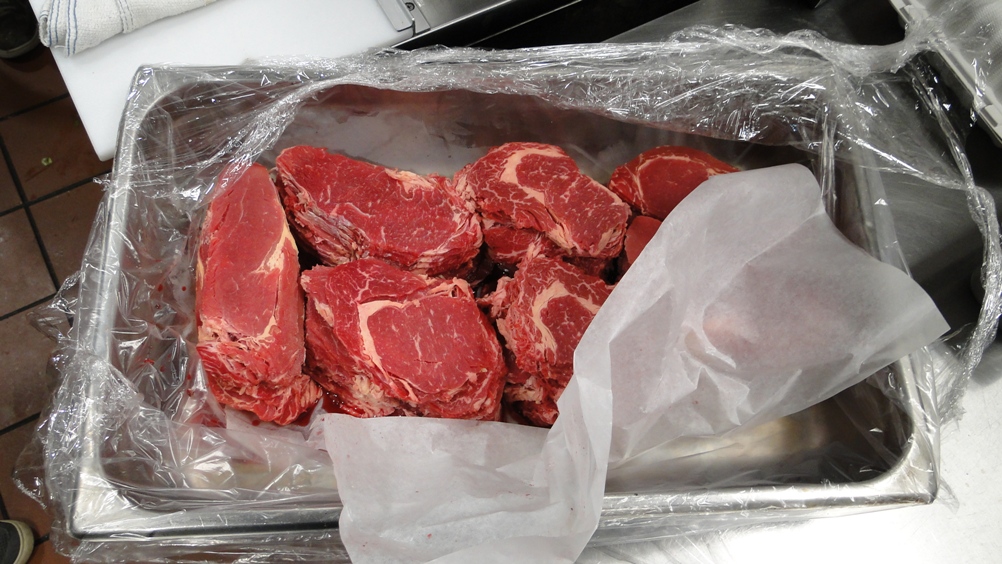
It’s the meat. Geno’s won’t have it any other way.
Dan Goldberg, co-owner of the Foodie Hall in Cherry Hill that now offers the essential Philly sandwich, helped to make this unprecedented happening possible.
“We’re very excited about it,” Goldberg says. “Our PR firm had a relationship with Geno, and made the introduction. We pitched Geno on the idea, and surprisingly to us, he was receptive.
“Geno’s has never expanded outside of Philadelphia, ever. So for us, this was a really exciting opportunity. Geno toured our facility, was very impressed with the layout, the cleanliness, and the whole thought that we put behind it, and said he was interested.”
And so you know, Goldberg didn’t just throw a few bucks at Geno Vento to use his signage. Thankfully, Geno is more protective of his brand than that.
“We worked out our deal, and went through extensive training with Geno to make sure that the Geno’s steak you have here in Cherry Hill is the same Geno’s steak you’ll have in South Philly. Which is not only important to us, but obviously important to Geno as well. It’s literally his name on the marquee.
“Geno was adamant, because he’s approached all the time, he wants to make sure there’s consistency across his locations.”
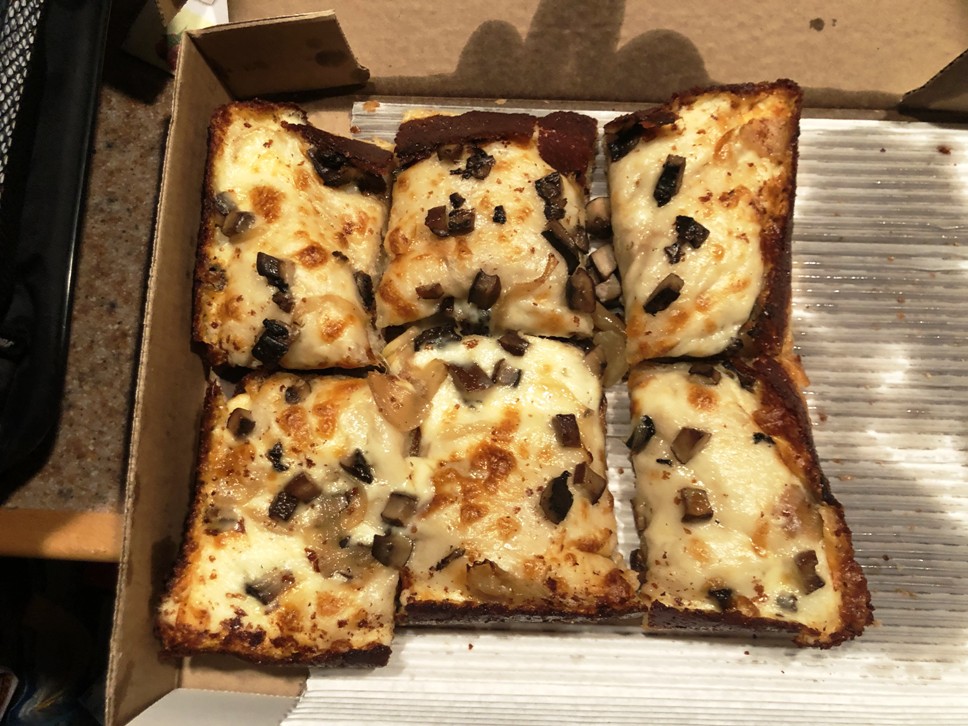
Not just Detroit-style pizza…Detroit-style pizza created by a gourmet chef.
To successfully persuade Geno’s to be a part of Foodie Hall is obviously a significant accomplishment. But it gets better.
Foodie Hall opened for business in May of 2022 offering a novel idea…multiple types of cuisine available for takeout and delivery. No more settling, they proudly proclaim. If your family bickers frequently over what to get for dinner, or your sports watching buddies can’t decide between pizza or burgers, Foodie Hall is your solution.
To be sure, maybe any-cuisine food delivery isn’t what you’d call a novel idea these days. As many restaurants in New Jersey were forced to close in response to a virus, many of them were offering takeout and delivery options to stay viable. If your local diner was doing this, you could probably choose from a varied menu and have DoorDash or GrubHub bring it to you.
Foodie Hall is revolutionary in being designed for the purpose of delivering higher quality food…whether it’s tacos, chicken sandwiches, or dumplings. Hop onto their website and order from menus that include Detroit-style pizza, Korean BBQ burgers, chicken Quesabirria burritos and much more. All chef-inspired creations.
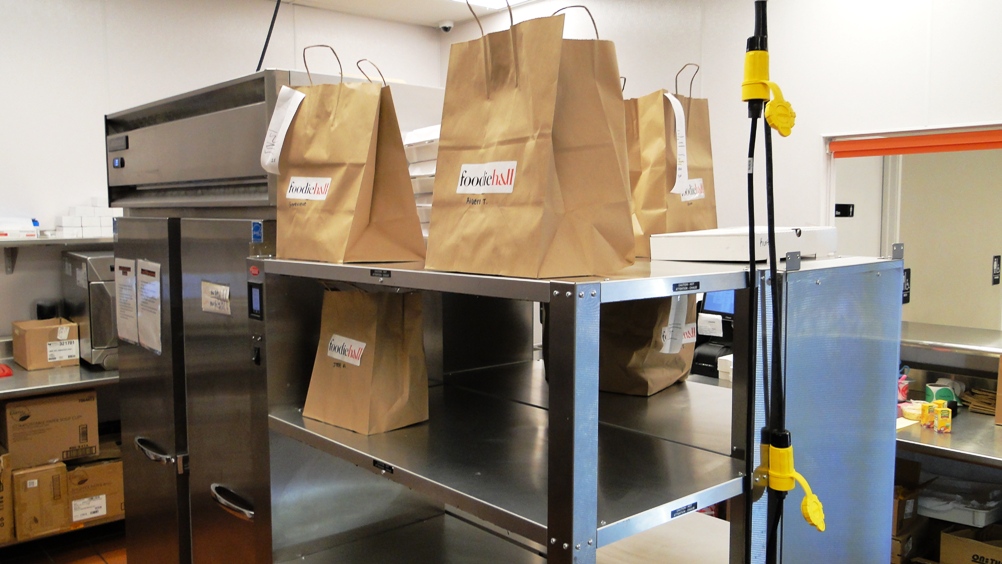
Since the pandemic, the trick is to keep food warm.
In case you’re wondering, Foodie Hall wasn’t conceived during the pandemic. But the sudden pivot towards takeout and delivery definitely gave the idea a boost.
“In 2018-19,” Goldberg remembers, “my original founding partner (Nick Ballias) and I, we met at a food event that I co-chair, called Men and Women are Cooking, that raises money for the Atlantic City Boys and Girls Club. This was when GrubHub, Uber Eats and DoorDash had come to Atlantic City, and it was starting to blow up.
“We started coming up with an idea for a delivery-only restaurant. We had penciled this out already, and then Covid hit and restaurants closed, and all of a sudden everyone was ordering delivery.
“My parents were telling me how they had ordered Morton’s for dinner. That’s when it struck me, there are people whose consumer habits have now changed and will never go back. It’s no longer just wings and pizza. There’s my parents, who are not exactly the most tech savvy, ordering steaks for dinner, that means anybody can be ordering everything.
“So why not come up with a restaurant concept that had multiple different types of cuisines on it? We ran into this family idea, where the parents want adult food and the kids want pizza or mac and cheese. Or the parents can’t agree. Or you have a group of friends watching football and they all want something different. Rather than settling, let’s have something for everyone.”

The conveyor belt. It seems so obvious if you’ve owned a dry cleaning business.
Sounds great, but how could that all work? A conveyor belt is a big part of it (!), but Goldberg says every step of the process matters.
“We put a lot of thought into what delivery trends were taking place, what was working and what we saw that wasn’t working,” he remembers. “Packaging was a big piece of it. Many restaurants during the pandemic that were doing delivery kind of out of necessity were using takeout packages. Those packages are not meant necessarily to be reheated, or to be leak proof, or to sit in a car for half hour or to retain heat or cold.
“We looked at packaging specifically meant for delivery. We wanted something that would maintain heat and not leak. We literally made products in our kitchen, put them in different containers, and had them sit in our parking lot for half hour or drive around and see how they held up. We wanted packaging that would be eco-friendly, and also able to be reheated in microwaves and ovens and things.”
Then there’s the little matter of creating a wide variety of cuisine from one kitchen, maintaining quality, and somehow keeping overhead down.

Some ingredients are astoundingly versatile.
“We are very conscientious in the ingredients we use to be cross-utilized across all the platforms. For example, chicken breast is used in multiple products across the different restaurants. I have a chicken parm sandwich at Criss Crust, and we have the chicken sandwich concept, Simply Fowl, and then we have salads that have grilled chicken on them. We’re trying to use things across and that keeps us more efficient.
“When we designed the kitchen, we were concerned with having a traffic issue, with people walking around and bringing all the various foods to the front. It would have been a waste of labor. We came up with a solution which I borrowed from my old business…a commercial laundry business…where we had a conveyor belt. It’s a 120-foot conveyor belt that runs down the center of our kitchen.
“I don’t need people running up to the front and bringing the food, I don’t have to worry about people walking into each other. It’s a way to keep costs down and keep order in the kitchen.”
The conveyor belt concept is indeed impressive to witness. An owner of a busy diner might see it and wonder how in the world they didn’t think of it.
“No one’s ridden on it yet that I know of,” Goldberg jokes.

Craft burgers. Just because craft burgers.
JerseyMan loves telling readers what makes life in South Jersey great and highlighting business ingenuity among our own. Places like Foodie Hall give us plenty to work with.
In the days before smartphone maps, you might have had a difficult time finding the place. It’s situated in an industrial park in Cherry Hill, just off of Route 70 but requiring navigation of annoyingly tricky jug handles and intersections. If it were a sit-down restaurant, the difficulty getting there might be a factor in your going elsewhere.
But for this style of eatery, the location is the beauty of it.
“We are delivery and takeout only,” Goldberg says. “We need to be near people, and we need to be near businesses, but I don’t need to be on Route 70 or Route 73. I just need accessibility, I don’t need visibility. We built out this really high-end large kitchen, with the latest and greatest in equipment, but I’m not paying the prices I would pay to be on Route 70 or 73. It’s more economical to be here.”
Market research drove the location of Foodie Hall’s first outpost in Cherry Hill. Even though it seems obvious.
“Between Cherry Hill and Mount Laurel and Maple Shade, you have a tremendous number of people that are foodies. It really fit well for us.
“It has a great mix of residents and businesses. We can cater to people in their homes at nights and weekends, and our concept lends itself perfectly to office orders and catering during the day. We’re getting a lot of offices that typically order once a week, same idea as from home. Instead of having 20 people fighting over what we’re having for lunch, now 20 people can get what they want in one delivery.”
Including an authentic Geno’s cheesesteak, without the tolls and traffic.
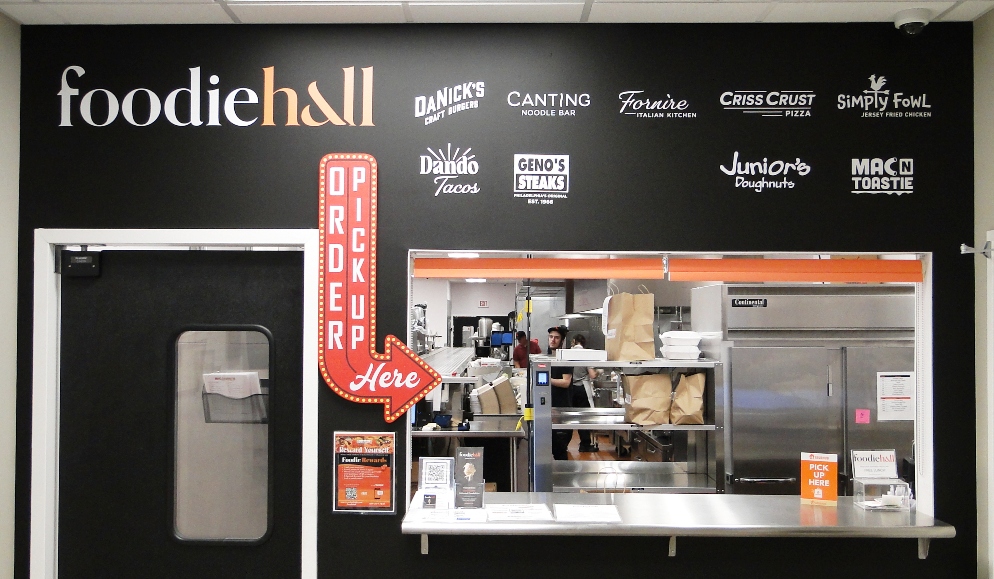
“Wow, you can get DaNick’s here?”
Establishing The Brand(s)
Foodie Hall features eight restaurants under its umbrella as this sentence was written, including Geno’s Steaks, an instantly recognizable brand to Philly area natives.
You can order Mexican street cuisine from Dando Tacos, Jersey fried chicken sandwiches from Simply Fowl, craft burgers from DaNick’s, Buffalo chicken mac and cheese from Mac N Toastie, or vegetable dumplings from the Cantina Wok & Noodle Bar. If you’re going Italian, try the Criss Crust Detroit-style pizza, or the antipasti from the Fornire Italian Kitchen.
Seeing the choices, a South Jersey food enthusiast could wonder how they have lived here so long without recognizing the catchy names and logos sitting alongside Geno’s. How does anyone miss Mac N Toastie?
When questioned whether the others are established eateries in their own right, Dan Goldberg considers it a triumph of Foodie Hall’s design.
“I’m glad you asked that,” he explains, “because they’re not. The fact that you asked that question means we did a good job of branding and trademarking to look like they are established brands. And the idea is that these brands will proliferate and open up in other Foodie Halls.
“There was a lot of thought given to the name, the logo, the design, the color scheme, to make it look like a franchise or an established restaurant. But they’re all our own creations, we came up with them. We put the menu together, the recipes, etc.”
That includes DaNick’s, which sounds perilously close to DiNic’s, the long established roast pork sandwich destination in the region.
“No, different name,” Goldberg responds when asked about the similarity. “They’re actually named after (co-founder) Nick (Ballias) and I, Dan and Nick. Nothing to do with them, we love their sandwiches, but yes, completely unrelated.”
So foodies in the area can rest easy knowing that they haven’t missed out on Fornire’s, and a potential topic for their blog.
But if you’re one of those types, the clock’s ticking on trying out Foodie Hall before your blogosphere competitors do.

You’re probably pretty good at cooking if you’re seen with this guy. (photo courtesy of Georgeann Leaming)
Key Players – Georgeann Leaming
Dan Goldberg and co-founder Nick Ballias don’t mess around when it comes to takeout fare for discriminating South Jersey natives. While working out the plans for Foodie Hall, they considered product quality important enough to bring a chef on board to be a culinary consultant, and design recipes for their menu of food creations.
Not just any chef, by the way…they partnered with Georgeann Leaming.
You may have heard of Leaming…she’s been a champion TV chef on Food Network’s Chopped, and competed on Hulu’s Man vs. Master. She’s been an executive chef for two of Gordon Ramsey’s restaurants, and has co-owned two food stops in Philly. One of them, Samwich, took Philadelphia Magazine’s “Best Fried Chicken Sandwich” prize in 2016.
That’s just a partial list of Leaming’s street creds in Philly area cuisine, but it’s enough to see why Dan and Nick would take the opportunity to work with her.
“It was very important for us to not simply have your average burger or chicken sandwich. We try to do everything higher end than your normal delivery would be.
“She left to pursue some other avenues in September, but she was with us all the way. She helped us design the menus, and some of the dishes were completely her own from top to bottom in terms of the ingredients, the recipes and everything. These are recipes that we use, and we haven’t changed anything since she left.
“Georgeann was a big help,” Goldberg acknowledges. “Fantastic, talented chef, culinary director, and really helped design and get this to where it is. Perfect person for this, and without her, we wouldn’t have the type of food that we have today.”
The decision of what to get for everyone in the room isn’t the only comestible conundrum Foodie Hall solves. If you’re looking for cuisine inspired by a top chef in the region without the triple-digit price, they take care of that for you too.
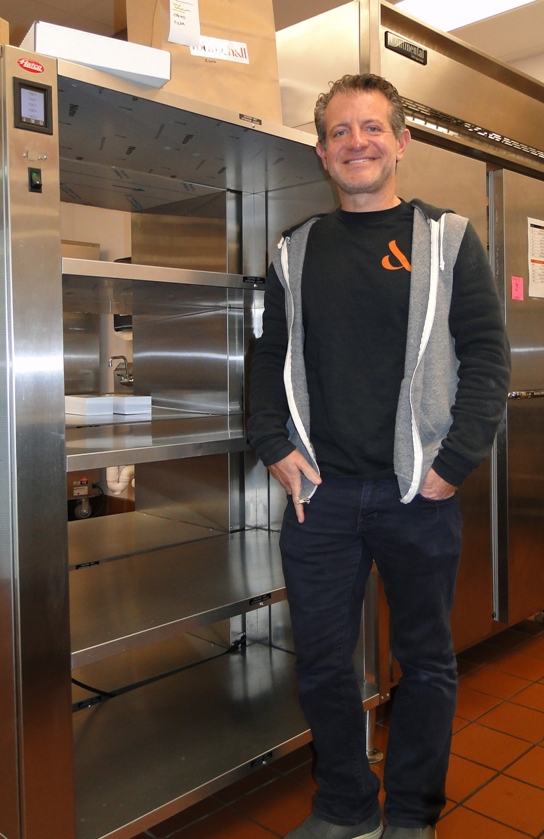
Dan Goldberg, FoodieHall co-owner, feeding people everywhere.
Meals 4 Meals
Dan Goldberg and his people consider giving back to be part of the ethos of business success, and they offer an incentive to philanthropic types who love great food. For every meal ordered from Foodie Hall, they donate a meal to Feeding America through their Meal 4 Meal program. On Foodie Hall’s website, they call the initiative “a vitally important guiding principle in how we operate.”
Goldberg is happy to explain how it works. “What they do is, they will take a monetary donation that they get a lot more mileage out of than we would, because of their immense buying power. We donate an amount to them for every meal that we sell, which is the meal equivalent for them. They use that to purchase meals for their partner charities, which are all across the country and the world.
“We initially got the idea from the Bombas Socks people. For every pair of socks that they sell, they donate a pair to people in need in a country outside of America. And we loved the idea. It made a lot of sense to us.”
So when you order from Foodie Hall, you’re not only providing all your guests or employees something for their own tastes, you’re making a contribution to a four-star organization with 200 food banks and over 60,000 programs to help feed the hungry in your own homeland. Not that you need any extra incentive to try Simply Fowl’s Nashville fried chicken sandwich, but it doesn’t hurt.
“By our calculations,” Goldberg estimates, “We’ll be donating about 50,000 meals in this year, which is really exciting. I’m very proud of that.”

Collectors And Sons – The CollX Sportscard App
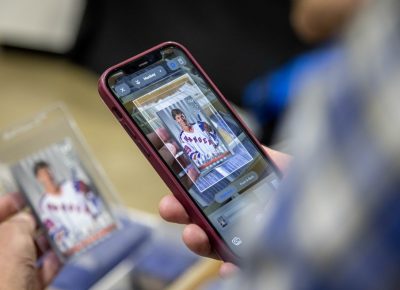
JerseyMan sent me to interview Ted Mann and talk with him about his new app, CollX, which helps sportscard collectors easily find the value of their cards. Love fun assignments like this! You can read the article on JerseyMan’s website here, or view the PDF from the magazine here.
(All photos courtesy of Ted Mann unless otherwise indicated.)
Collectors & Sons – The CollX App
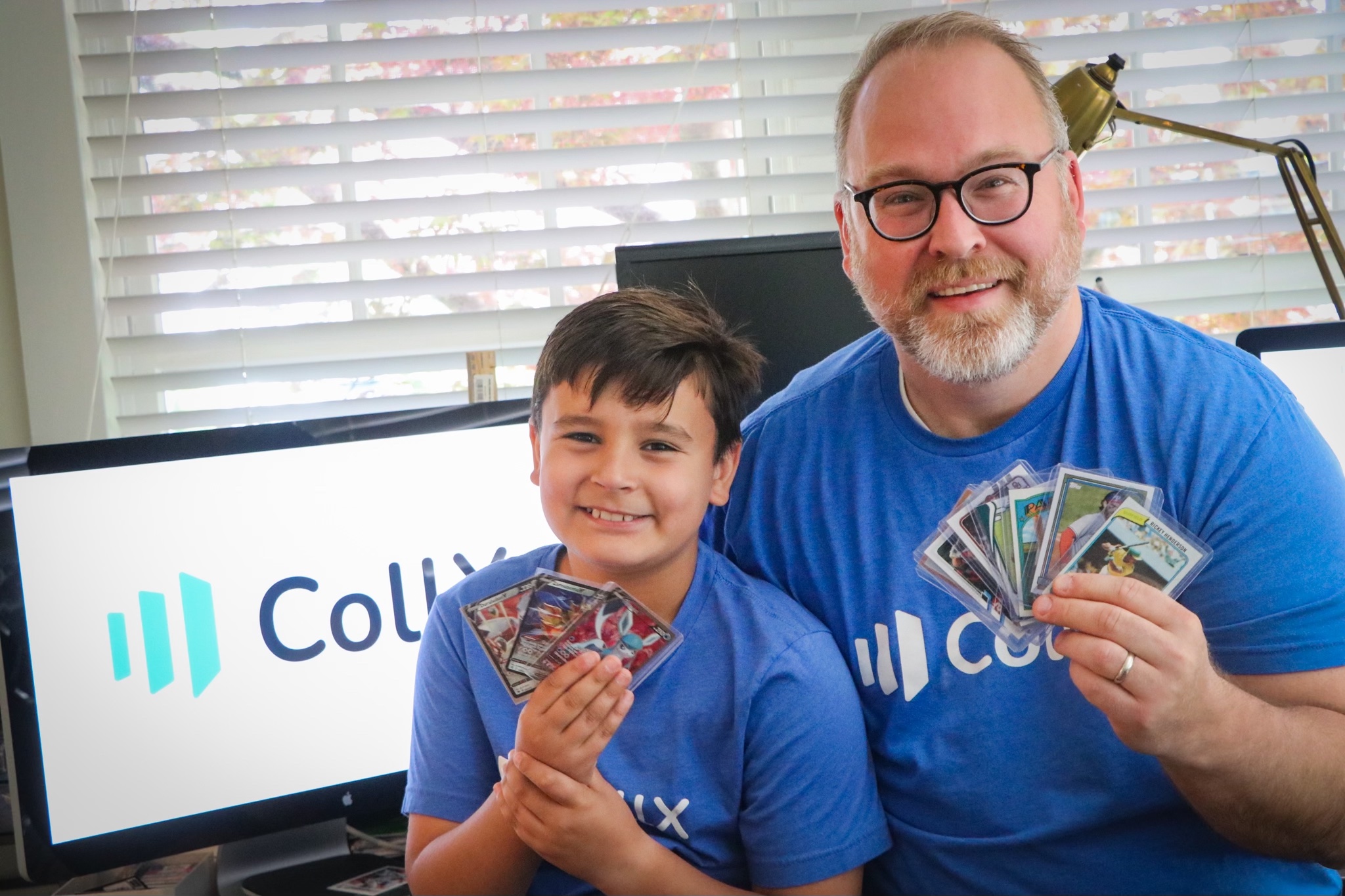
Two geniuses at work.
There is a new app available for sports card collectors that solves a decades-old problem…finding out how much your sports cards are worth. It’s called CollX, and the idea was hatched by a ten year old.
The wonderful thing about young children is that no matter how overwhelming a problem, they always see a simple solution.
And as any sportscard collector knows, finding the true value of cards is a pretty overwhelming problem.
Ted Mann, a former journalist, has just started his fourth technology company using visual search technology. It’s an app called CollX, and it’s an idea that is so obvious that adults need kids to help us see it.
Fortunately, Ted has just such a visionary living under his roof…his ten year old son Charlie, who saw how his father’s technical skills could make the world a better place.
The CollX app does the most important thing apps do…it saves collectors lots of time. With CollX, you can dig out that dusty collection of sports cards from your attic, scan each card, and instantly see its approximate worth. (Incidentally, if your cards are worth anything, hopefully you’ve been wise enough not to let them collect dust.)
No more poring through Beckett or Tuff Stuff guides, no more hauling your collection to a broker, no more countless hours on eBay. Ted and Charlie tried all those things with their collections, until Charlie suggested a better idea.
Ted gives all the credit where it’s due.
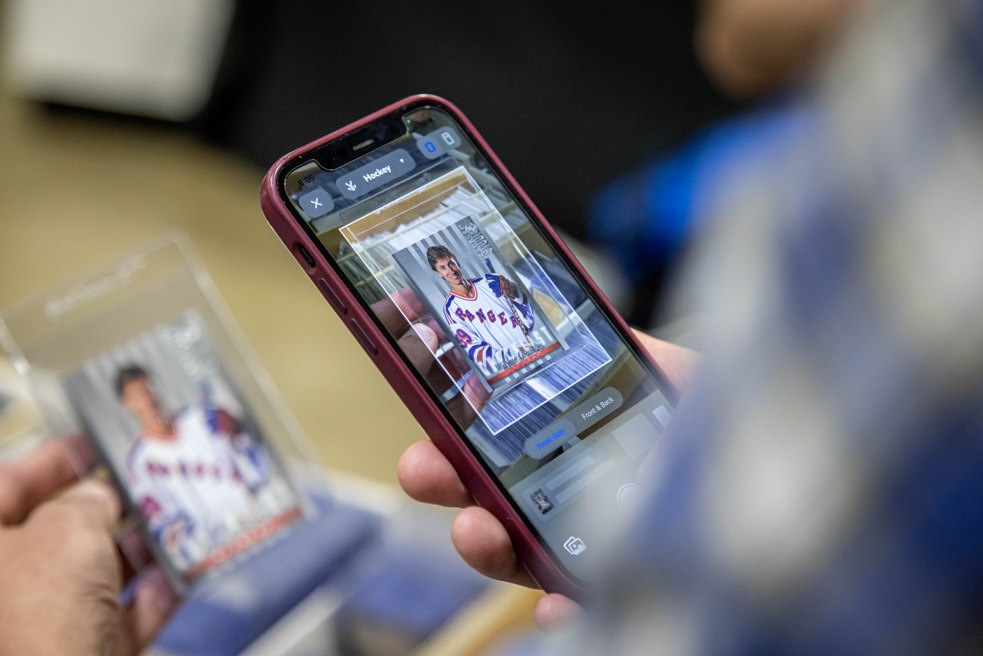
It’s obvious enough that we need a child to think of it.
“When I was a kid, I ran into the same problem that Charlie had. Tuff Stuff Magazine, listings and prices, I also used Beckett back then, looking things up manually.
“But the Beckett Guide has become like a phone book. It’s super thick. It’s really, really tough and time consuming to look these things up, and even when you do, I was finding that the prices in the Beckett Guide, probably the minute they’re published, are out of date.
“We found some apps where you could look up cards, but they were really expensive, high value cards, which sad to say, did not fit the description of my collection or Charlie’s.
“We tried one thing after another, and finally Charlie’s like, “Dad, can you just build me something that would do this?”
Cue the light bulb.

Baseball card valuation on the fly.
Childlike vision works because adults can’t believe some things can be easy, like finding the actual value of a Cal Ripken Jr. rookie card. As a result, many of us let valuable memorabilia collect dust in the attic.
Charlie provided the inspiration, but as Jersey native Thomas Edison informed us, genius is 99% perspiration. Ted is well aware of this, and he’s been putting in the sweat. CollX is all about making a difficult and tedious process easy…but developing the app itself has been anything but an easy process.
It’s not the easiest to market research, for one.
“It’s easy to go and ask people around town, do you have any cards? ‘Yes.’ Do you know what they’re worth? ‘No.’ Have you ever sold a card on eBay? ‘No.’ Why not? ‘I don’t know what they’re worth.’
“It definitely gave me optimism that there was something big here. But understanding how big a market it is was a challenge. We did assess that basically, thanks to eBay and other marketplaces. The current market size is about 5.4 billion.
“But what about all those people that have never sold on eBay? Could you get them to do it? Could you get them reacquainted with their cards and back into the hobby?
“We actually had to conduct a pretty big omnibus study to get a sense of that…just this afternoon, another news outlet called New Street published the findings of our research. The big takeaway was that there are about 85 million American adults that own trading cards.
“It’s a huge 33% of the population, and yet none of them, or I should say a small percentage of them, have ever transacted on any kind of market like eBay. The thing blocking them isn’t necessarily getting the cards graded or having access to a place to sell them. There’s still a lot of card stores, there’s a lot of online sites. It was simply not knowing what the cards are worth, and not having a good way to figure that out.
“If we can help solve that problem, then this huge addressable market can be unlocked.”
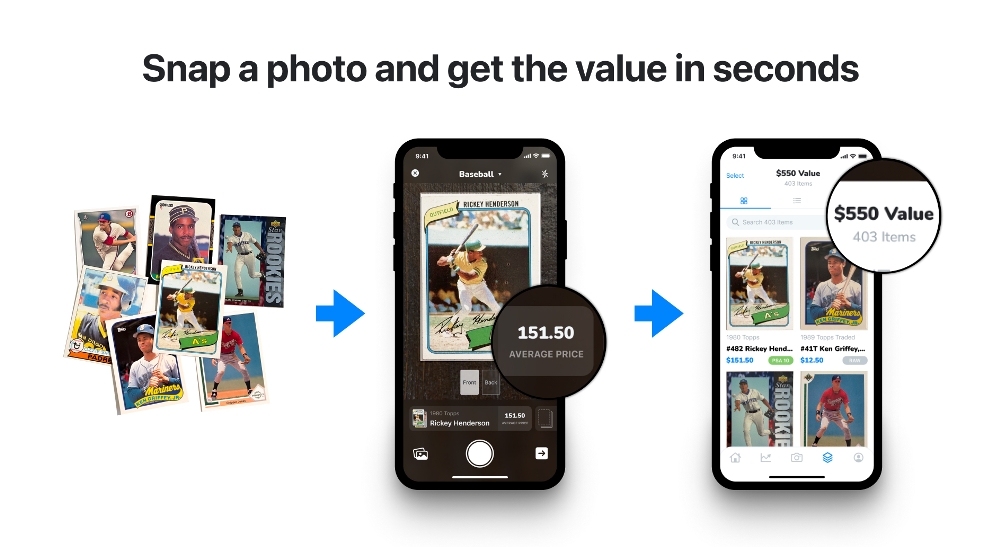
That thick book is why people didn’t bother.
There is also the sheer number of collector’s cards…the CollX database features 20 million, and most definitely counting.
It’s an ongoing process, Mann says. No kidding.
“We still don’t have every card by a long shot. There’s a few cards in my collection that I still can’t scan into CollX, because we haven’t gotten those images or gotten that data into our database yet.”
Spoken like a true entrepreneur…20 million is nowhere near enough. Just how, exactly, does a database of 20 million sportscards get constructed?
“We found a number of sites online, all publicly available sites, that have checklists. In the trading card world, you can build the set, right? And there’s a list of every card in that set. We started building those checklists, and then populating all the images for all the cards in those checklists.
“We started with baseball and then we added football, baseball, basketball, hockey, soccer, wrestling. Soon we’re gonna add trading card games like Pokémon.”
Mann says that they have also developed what he believes is a generally accurate algorithm for determining each card’s worth.
“We’ve built up a ton of pricing data, most of which is coming from other auction sites. Again, publicly available and all readily searchable, eBay being the biggest. We’re taking all of those transactions and mapping those back into the individual cards.”
Arduous task, undoubtedly.
But the CollX app keeps improving, and its usage keeps growing.

One of over 200,000 users at a given time.
During JerseyMan’s interview with Mann, a counter sitting on a nearby shelf occasionally made clicking noises and changed the number it was displaying. This counter, Mann explained, shows the number of people using the app at a given time. At that moment, the number was 232,408 and growing. There are plenty of curious collectors out there.
But Mann and Son’s E-Z Sportscard Valuation Service has bigger plans…not just helping users find the worth of their cards, but also facilitating the sale process if they are inclined, and ultimately monetizing the app through commissions.
“We’re a very early business,” Mann says. “We aren’t charging for the app. We know there are already users reaching out to other users to buy their cards…we see that happening in big numbers. We’re going to help them do that better, so we’ve created a number of tools.
“The first big tool is our deals feature, where you can negotiate on multiple cards. You can create a deal with a bundle of cards and negotiate on the lot. We’ll facilitate checkout and generate shipping labels, to ship the cards via the postal service.
“We want to help people make a lot of money on their collections. But the thing I think is really unique is, on CollX, you actually see what the buyer and the seller both have in their collections. That enables us to say, here’s the areas where you have a shared interest. If you really like the Phillies, Bryce Harper, we’re gonna surface those cards from my collection. When you add something from my collection, now here are a few other suggestions of other cards you might be interested in.
“We can build those recommendation systems in a really personalized way, and I think it creates a better experience.”
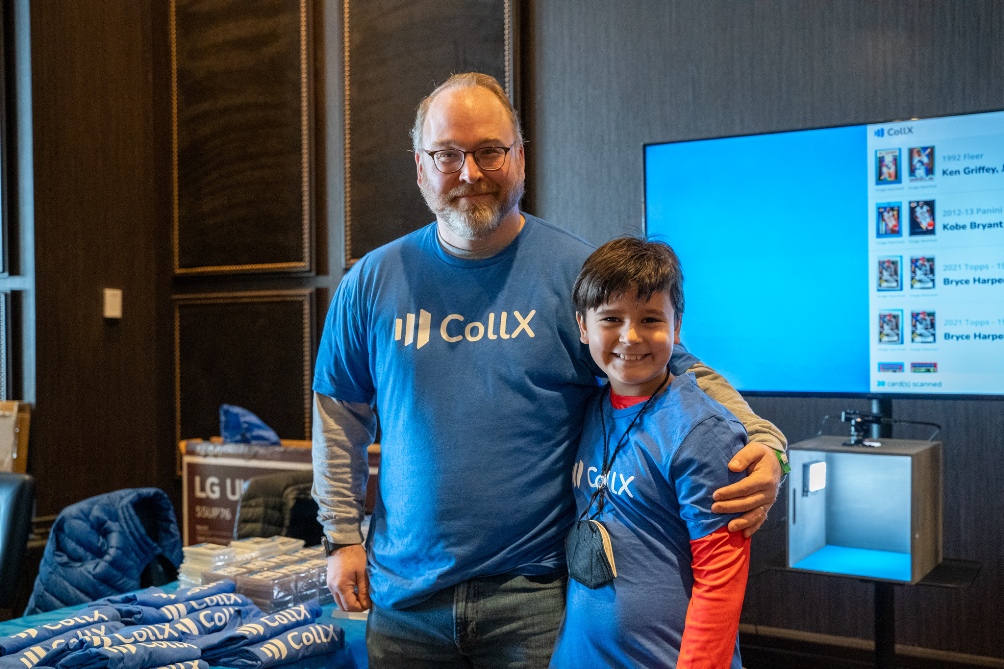
Father and son bonding through baseball cards…it’s as American as it gets.
There are few better opportunities for fathers to tell their sons about athletes of their era than when leafing through a collection of sports cards. Imagine building a business around it with your son. Charlie Mann is getting a solid grounding in both…even if he still gets more stoked about interviewing Rickey Henderson, which he did at a recent sportscard event.
Charlie is obviously not old enough to remember baseball’s greatest base thief, but as Ted says, he knows plenty about him.
“He was super excited to talk to him, because that was one of the cards that he pulled out and he was like, ‘Dad, is this one worth anything?’ I was like, ‘That might actually be the most valuable card in my collection. It’s his rookie card. Let’s go try and figure that out.
“And sure enough, it was one of the more valuable cards. So when Charlie got to interview him, he shared that story. Rickey was really nice. I was really impressed with him.”
“I love getting to do this with Charlie,” Ted continues proudly. “It’s been a great way for us to bond and connect, and it’s not just us. I’ve noticed and seen and heard from countless users on the app that it’s been the same thing for them. Just fathers and sons, getting to bond over collecting cards and to do this together. I think for Charlie that was super gratifying too. To see it wasn’t just him that had this problem.
“And he’s helping all these people.”
Sometimes, the kids really do have the answers.
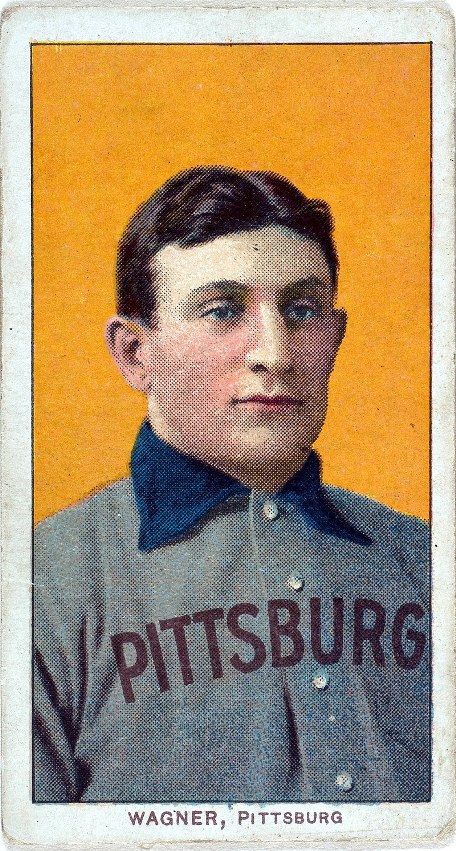
No, you can’t sell a picture of the card. (image courtesy of Wikimedia)
The Honus Wagner Card
As every baseball card collector knows, the T206 Honus Wagner card is the most valuable baseball card in history. In August of 2021, the card sold for a whopping $6.6 million.
Why is it so valuable? According to Wikipedia, in 1912 Wagner was asked permission by the American Tobacco Company, who manufactured baseball cards at the time, to have his visage included on a card. Wagner refused for reasons that still aren’t clear today, with theories ranging from his not wanting to advertise tobacco to kids to his being a tough negotiator who demanded greater compensation.
As a result, just 50 to 200 Honus Wagner cards were produced, and given his stature on a baseball field, this almost immediately made the card valuable.
Ted Mann well knows the value of scarcity in collecting. It was unintentional in the American Tobacco Company’s case (then again, maybe it wasn’t), but Mann says that card trading companies do intentionally create scarcity.
“The manufacturers of these cards create small print runs for certain cards. They’ll say, there’s only ten of these cards. It’s like your golden ticket. Golden auctions sold, I think a one of one Mike Trout rookie card for like $5 million. There’s only one of them, so that creates demand.
Mann doesn’t believe a Honus Wagner card will be scanned on CollX. He stresses that the app is more for “the rest of us”.
“I don’t think we’ll see a lot of $7 million Honus Wagner cards scanned in the collection. As much as I’d love to cater to the high end of the market and have them see the value on the app, I think it’s really kind of the rest of us, the long tail of the collecting hobby that we’re really appealing to.”
The value of some cards brings to mind a potential problem that Mann is also working to address: potential forgeries.
“It’s difficult, forgeries of cards is a tough thing to identify with just a picture, especially if they’re pretty much identical. Obviously, you wanna take a picture of the card and if for some reason you do receive a fake and you’re able to see that, you can report that. And we would not release the payment to the seller if they were peddling fake cards.
“I think there’s definitely some things that we can do to double verify it. But we will protect the buyer and make sure that they get the cards they paid for.”
Something to remember just in case you find yourself seeing a Limited Edition Honus Wergner card for sale.
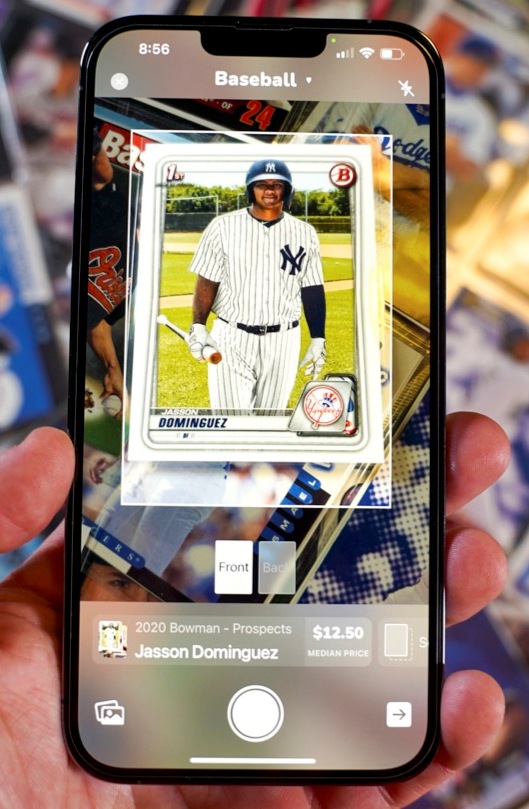
Yes, it looks like him, but let the image recognition decide.
Image Recognition – The Key to CollX
Ted Mann is an expert at how image recognition, a remarkable technology that CollX employs to determine what sports card it’s looking at. His son, of course, was aware of this when he suggested the idea of using it for sports cards.
“What we’re doing with CollX is a specific breed of image recognition that is sometimes called reverse image search, or reference image matching, where we have an existing reference image of a card. We’re trying to match the picture of the card that somebody’s taken on their smartphone to an image in our database.
“Think about it almost like matching fingerprints…when you’re matching a fingerprint, you don’t necessarily need to match everything about the fingerprint. You’re looking for the little variations that kind of define it. We kind of do the same thing. We have a deep learning model that is trained to identify specific features within each card image, and then we’re just trying to match up one to one.
“Imagine if the trading card itself was a QR code. And you’re basically just identifying that and matching that to an existing one in the database to get that one to one match.”
The explanation of the technology obviously goes much deeper, but Ted’s happy to take care of that for you so you and your son can scan your cards.

Be a part of the sportscard valuation community…
The Collector’s Community
Ted and Charlie and partner David Grzybowski recently attended a sportscard event in Atlantic City, where they were quite well received…and encouraged.
“I met probably a thousand people at the national in person who just really love the app. A couple of them came to me with a laundry list of features they’d love to see, which is great too.”
Incidentally, the audience for JerseyMan might find CollX right up their alley. “There’s a high overlap rate of entrepreneurs and card collecting,” Ted says. “It’s actually kind of a funny, it’s how a lot of them got started. I guess myself included.”
To Mann, the enthusiasm for CollX is an opportunity to improve things in the app, such as the accuracy of pricing, which has limits coming from auction sites where prices can vary.
“A lot of our data relies on eBay transactions and a lot of eBay transactions are bogus, we’ve learned. So when those happen, just helping us kind of prune those out. We’re actually gonna have an app update pretty shortly that gives some of that functionality so that our users can help us with that.
“We’ve done our best to come up with ways to average the prices or estimate the prices if needed. But the truth is we need help and we have 232,000 users, many of whom don’t mind putting in a little bit of extra effort to help us.”
Entrepreneurs who listen should be valued. CollX’s customer service is already an improvement over both of the TV providers in my area.

The Magic of Mio
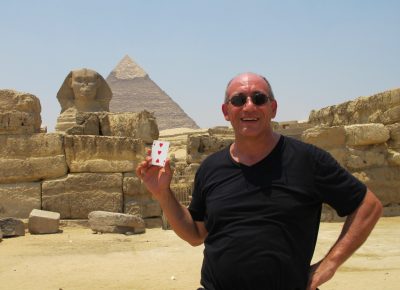
I was given the privilege of interviewing Mio Rodriguez, a magician and mentalist of very high caliber in the Miami area, for the relatively new MiamiMan Magazine. You can view the magazine on MiamiMan’s website here, or have a look at the PDF of the article here.
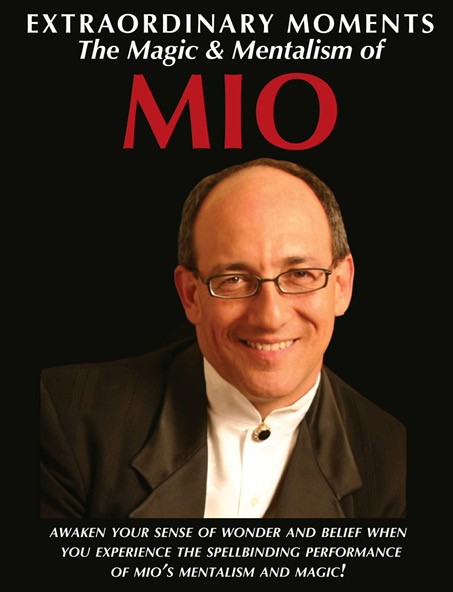
The Magic of Mio
Magic By Mio is a close-up magic and mentalism act that is mind-boggling enough to spread the word…even among some of the biggest stars in the world.
Mio Rodriguez is surprisingly polite while he makes your head explode.
Throughout our discussion, he repeatedly called this simple scribe “sir”, and thanked me for the interview in a truly sincere tone. He even threw in a brief performance free of charge.
Mio is unfailingly gracious and genuine…which, when you think about it, is an odd quality for someone whose career is about deception.
It’s a key component of not just his considerable lifelong success, but also being repeatedly invited to entertain some of the most well-known humans on Planet Earth.
Just for the record though, he’s really, really good at magic and mentalism too.
During the interview, he divined a digit I had mentally chosen from an eight-digit number on my phone’s calculator, and followed up by intuiting what I had just searched for on Wikipedia, guiding me with skilled patter.
It’s all tricks of course, but I was duly impressed…and couldn’t wait to play the recording for my children.
I’m not the only one.
Mio performs astounding card magic and confounding mind-reading tricks, both at an exceptionally high level. His goal is always to bring out the wonder we had as kids.
“I’ll do close-up magic, cards and coins in the cocktail hour, followed by a mentalism show after dinner. People come to me and say, ‘You know, the magic with cards was amazing. We didn’t see any sleight of hand, we just figured that’s how you did it.
“’But the mentalism…were you really reading our minds?’
“Mentalism is the new magic for adults,” Mio says. “They think they know how the card trick was done, but when it comes to mentalism, there’s still that childlike wonder…‘How the heck did he know what we’re thinking?’
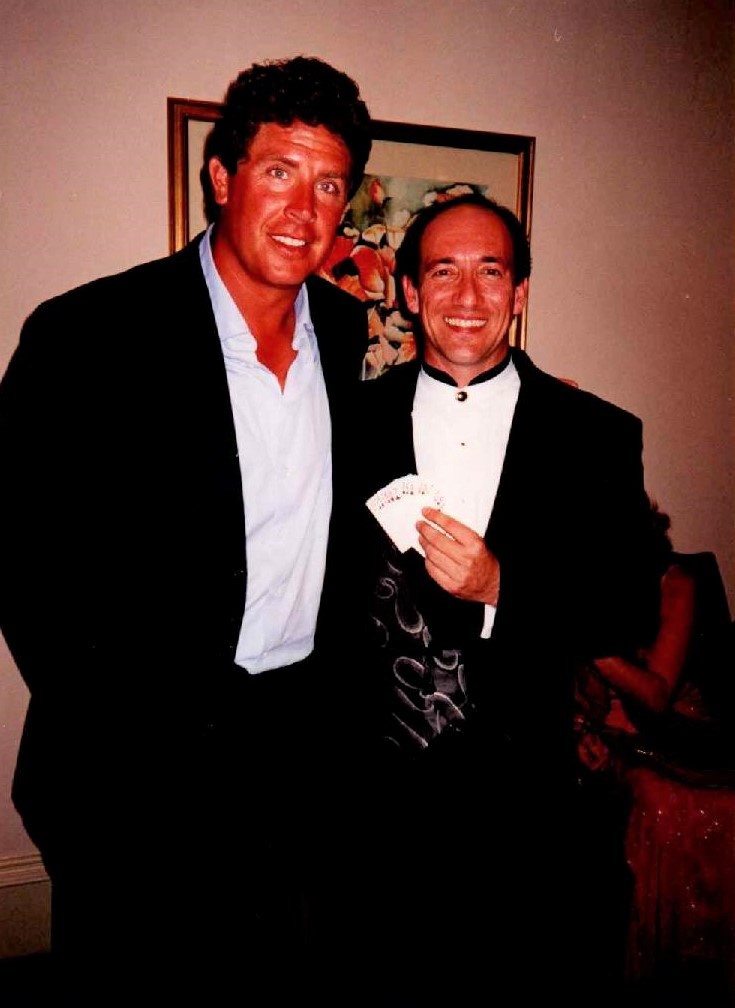
Baffling Dan Marino can help land a mentalist some prime gigs.
(photo courtesy of Mio Rodriguez)
Mio’s Magic and Mentalism Show is well known today…not just in Miami, but in the highly exclusive celebrity world.
The list of names Mio has dazzled includes not just Miami’s own Dan Marino, Shaquille O’Neal, Wayne Huizenga, and Don Shula. You can view many more on his website…Stallone, DeNiro, Jordan, Gretzky, and countless others.
It started with Marino, though. Or more correctly Mrs. Marino.
“His wife saw me at someone’s party,” Mio remembers about a fateful moment, “and she has me at a birthday party for Dan at the Signature Grand.
“He liked what I did, and he said, ‘I want you to come to my celebrity golf tournament.’”
At that tournament, Mio says, “I met Mario Lemieux, he said, ‘Wow, I love your stuff. Can you do my celebrity golf tournament in Pittsburgh?’ One of his guests was Michael Jordan.”
And so on.
Mio has plenty of amusing stories about entertaining celebrities. He remembers a Christmas gathering with Pat Riley’s Heat:
“Riley had seen me at a party, and he wants me to come to the Heat’s Christmas party. He liked it so much he hired me for 12 parties in a row.
“For the last four years I did the party, LeBron was there. The first three years, other players would bring me over: ‘LeBron, you gotta see this!’ He would be like, I don’t like magic, I don’t wanna watch. The fourth year, finally he goes, okay, let’s see what you got.
“I do my favorite effect, a signed card to a wallet. When I bring his signed card out of the sealed envelope, he was like, ‘oh my God, that’s too much.’
“I go, let’s do one more. I have an invisible deck in my hand. I throw it to him and say, take a card out invisibly, turn it upside down, and throw it back. He throws the invisible deck, when I catch it, there’s a deck in my hand. I go, ‘I caught a pass from LeBron James! Sir, what card did you put in upside down?’
“At this point, Pat Riley’s come over. LeBron says the king of spades. I spread open the deck and there’s a card upside down. When I turn it over, it’s the king of spades.
“And Pat Riley goes, ‘You got the King with the King!’”
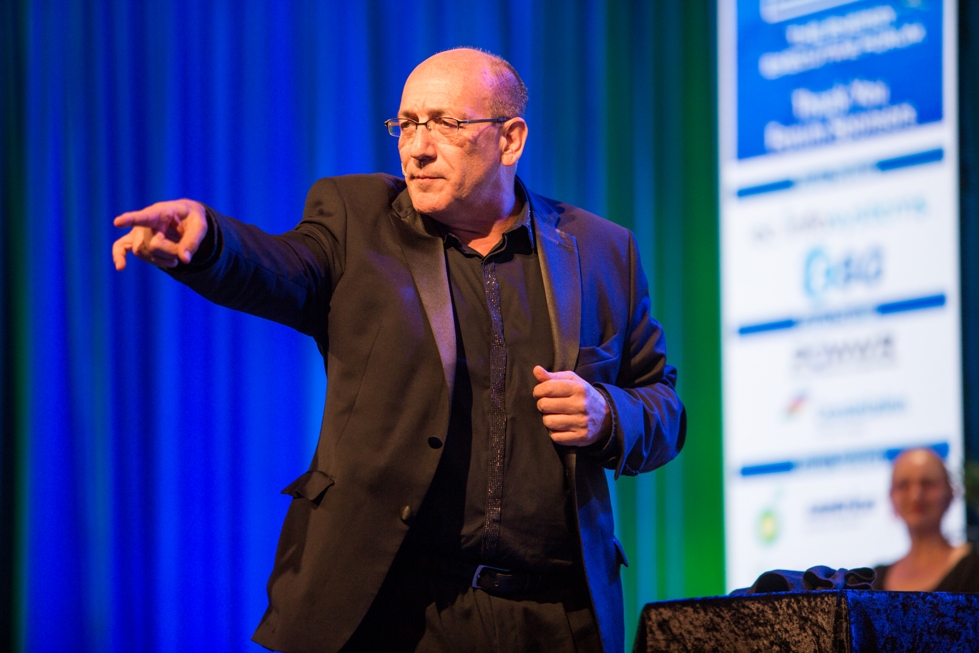
It takes years to develop this level of cool.
(photo courtesy of Mio Rodriguez)
It’s a fallacy that anyone is born to do anything, especially in entertainment. It discounts the deliberate intention to excel at a craft, and the persistence to convince others that your skills are worth a look.
Mio’s had life experiences pointing him to a career in magic, including coming from a show business family and performing in front of Mrs. Dan Marino. But he’s worked at it plenty, and he’s made his own breaks.
“My father was a professional costume designer and my mother was a dancer. In fact they met doing a show together. My father’s great love was magic, and although he wasn’t a professional, he was a very good magician. He would sit me on his lap and teach me magic with cards. When we would go to magic shows, he would tell me how things were being done.
“I just thought everybody’s dad knew, I didn’t know I was getting privileged information! I knew a few great card tricks, fun at a party or whatever, but I never thought of it as a career.”
But then one of those fateful nudges happened.
“A magician just happened to move in next door, who made a living at close-up magic. I’m like, ‘Wow, you can make a living?’
“He showed me an effect, and it turned out to be one my dad had taught me. I grabbed the deck and showed him my version, and he showed me his other version. Because I had some knowledge, he started sharing with me like I was a magician. He said, if you learn these seven basic moves of sleight of hand, you could be a magician.
“I studied and practiced, hours and hours a day for months and months. After about a year, I decided I was gonna try to make the transition and be a magician. I moved from Dallas to Florida in 1990.
“My friend was doing magic in restaurants; restaurant jobs are the basic fundamental stepping stone, the bottom rung of the ladder. I would come in Wednesday, Friday and Saturday, and go from table to table for a small salary and tips.
“Once I got those first jobs, I built off of those, then I started calling entertainment agents. I said, listen, I work at this restaurant, come in and have dinner, watch what I do and see if you like me. If you do, you can hire me for your private and corporate parties.”
A performer never knows when momentum is going to kick in. But years of hard work and making connections finally turned into “overnight success”.
“I gave my cards out for the first four or five years. Then one day I got a phone call: ‘I had your card for three years, we have a party.’ Then the next day I got a call, and then the next thing I knew I’m getting calls three, four, five times a week. All of a sudden business just exploded.”
“I’ve been working full-time for 32 years now. We’ve had a really great year here this year. People are coming back out of Covid, and it’s been some record numbers.”
Not bad for someone who started with a few card tricks at parties.

Entertainment that is welcome anywhere.
(photo courtesy of Mio Rodriguez)
As much as he enjoys the travel and performance life, Mio is planted in South Florida. It is, he says, a great place for a magician to call home.
“There’s a lot of corporations, conferences, and also parties, bar mitzvahs, all kinds of events. People come here and want to do something fun. Florida has a lot of people that have the ability and desire to have these parties, and they want great entertainment.
“I love Florida, the sporting activities, the fishing and the water activities. Even though it’s hot in the summer, the weather is overall fantastic. You’re not locked in. There’s so many opportunities here. It’s just a fun place to live.”
It’s an admirable lifestyle Mio’s carved out in the Magic City. He does quite well performing at corporate events, celebrity parties, and on cruise ships. His well-honed act sends him across the country…including Las Vegas, where magicians can be easily hired without travel expenses.
His lovely assistant…his wife Rhonda…performs a much more important function for Magic By Mio, Inc. than getting sawed in half. She handles Mio’s promotion, marketing, contracts, and the rest of the business end, so Mio can focus on staying on top of his game.
“It’s helped bring our business up,” Mio gratefully acknowledges. “She sends out all these email blasts and marketing that remind people of us, and they call us back, it just makes everything much more professional to have her.
“One job leads to another, because word of mouth is my strongest method of promotion. I don’t advertise. With the website there’s SEO, that’s the only thing I pay for.
“Things are newer, but back in the day, it was all word of mouth. And it still is.”
Those who have witnessed The Magic of Mio would agree. Just ask Pat Riley.
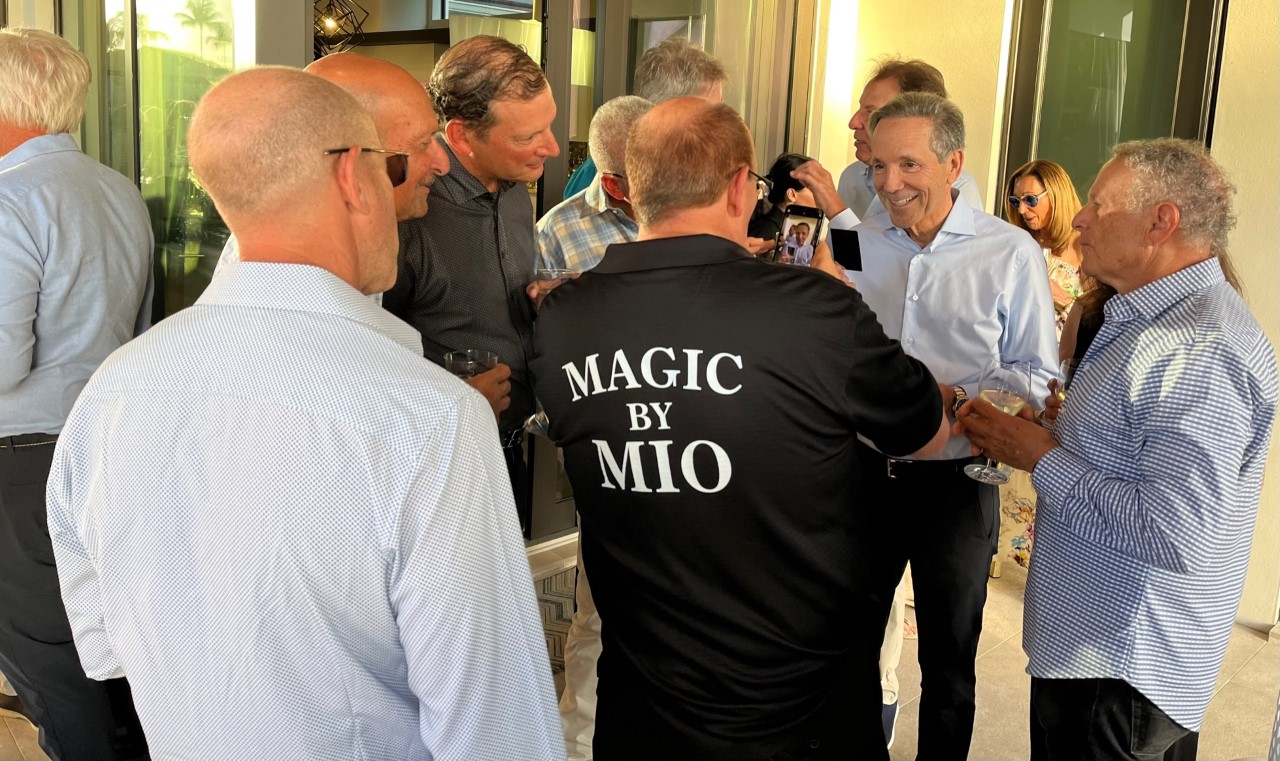
Magic that draws a crowd at your event.
(photo courtesy of Mio Rodriguez)
If You’re Interested…
MiamiMan probably doesn’t need to point out that if Mio is good enough to work the Heat’s Christmas party for over a decade, that his skills are exceptional enough to perform at a corporate event.
But he’s very easy to get a hold of, in case you’re interested…there is a contact form on his website, and his direct cell phone number is prominently displayed online as well.
You should probably contact him well ahead of time, though. Mio estimates that he performs about 145 shows a year, and many of those gigs put him on flights. The list of cities where he performs include Chicago, New York, Los Angeles, San Francisco, Washington, and many others, and his list of corporate clients includes IBM, Citibank, AT&T, UPS, Walgreen’s and many, many more.
You get it; Mio is in high demand…for his skills obviously, but also for his professionalism.
“For corporate, you want a really top rate entertainer who’s sophisticated. There’s a lot of CEOs, high level people, they’re spending a lot of money, and they don’t want anything hokey. They want to make sure they have a sophisticated entertainer who’s on a higher level, because they’re often wanting to impress other people.
“That’s what they get from me, and that’s one of the reasons I’m busy with so many corporate events, because once they find that out, the word also travels as well.
“I’m able to take care of their clients a professional, sophisticated, classy way, and that’s what they look for.”
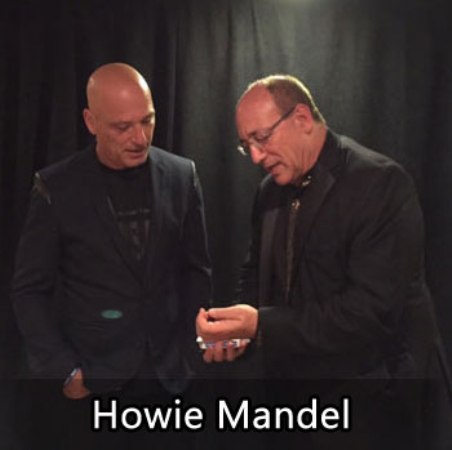
Deal or no deal?
(photo courtesy of Mio Rodriguez)
As (Almost) Seen On TV
Mio Rodriguez just missed…twice…on capturing nationwide audiences on a level where he could add a “notoriety fee” to his performance price. He auditioned for both America’s Got Talent and Penn & Teller’s Fool Us shows, and just missed making it to the show both times…for reasons that had nothing to do with any lack of ability or skill.
“On America’s Got Talent, they called me up and wanted me to come on the show. I was doing mentalism in the audition, and they told me, ‘You don’t even have to wait in line. We want you to come audition for us.’
“We rehearsed in the morning, and I had two or three mentalism effects that were ready to go, but the producer or the director at the time had never heard of mentalism, and he kept skipping me. They just didn’t really understand what mentalism was. Now, of course they do, they’ve had mentalists get to the finals.
“What they actually ended up doing was choosing another magician who wasn’t very good. He was triple-X’ed off. I guess they needed, I don’t know, some humor on the show. It really upset me to the point where I didn’t try to get back on it.
His exclusion from Penn & Teller’s Fool Us is even more inexplicable.
“Penn & Teller, before they had their show, they were at one of those conventions in Vegas, and they saw me do some moves with the cards. They said, man, that’s the best we’ve ever seen. We want to film you, because we’re doing a documentary about the convention.
“They never did do that show, but in the meantime, I auditioned for Fool Us. They said, here’s the date of filming, make sure your calendar is open.
“But in the end, they never called me back.”
It’s unfortunate that America hasn’t had a chance to see Mio’s act on television. Mio has had audience members tell him that he’s as good as David Blaine. And more personable.

“Wait, what?”
Women in Magic (Yes, They Exist!)
Have you ever given any thought to why you have seen so few female magicians? In fact, you may not have even given it thought…in terms of magic performance, you might simply be accustomed to women in sexy clothing, climbing into a box to get sawed in half.
There is a post on Mio’s website about this phenomenon and how magic is one of the rare fields that has not yet been fully infiltrated by the fairer sex. In it, he references the iconic “We’ve got a witch!” scene from Monty Python & The Holy Grail. As humorous as the scene is, Mio says, “its implications are quite horrifying.”
“Throughout history, up until the 18th century in fact, accusing women of practicing witchcraft and heretical sorcery was often a near-instant death sentence.”
In modern times, Mio notes that “many parents and relatives make assumptions about the interests children will take up based on gender. Men are encouraged to pursue fields like sports and sciences based on gifts like athletic equipment, chemistry sets and magic sets. Women, less so.”
But Mio says this is changing, and points out an inspiring success story in particular.
“I have a good friend who is a magician, and he gave his niece a magic book when she was 13. She loved it, she started learning magic, and she declared at a young age, I’m gonna have a show in Vegas when I grow up, I’m gonna be a woman magician who has a show in Vegas. Lo and behold, she just celebrated her 500th show last week.
“Her name is Jen Kramer, and she’s one of the few women magicians right now that have a big show in Las Vegas. She basically created that for herself, she manifested that by saying, yes, I’m gonna be a magician, I’m gonna have my own room in Las Vegas.”
“That’s the kind of orientation, goal setting and tenacity that it takes for a woman, let alone a man, to do that.”
You can learn more about Jen Kramer at her website.

Steve Friedman – Champions of Cheltenham
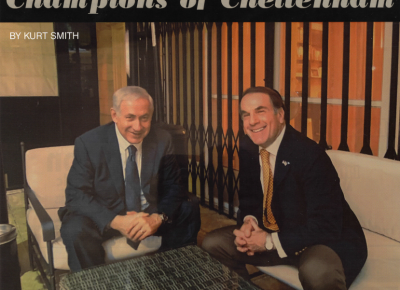
For the Winter 2021 issue, JerseyMan sent me to interview Steve Friedman, a Philadelphia attorney for the Duane Morris Firm (he is since no longer with the firm). Steve is close friends with Israel Prime Minister Benjamin Netanyahu, and he told me a few stories about Bibi and his character. You can read this on the JerseyMan site here, or read the PDF from the magazine here.
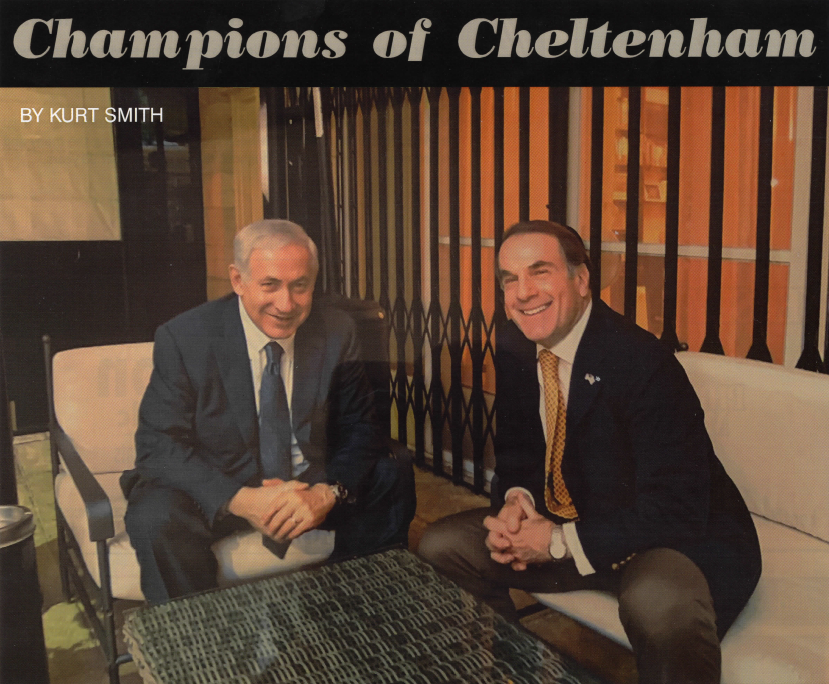
Champions of Cheltenham – Steve Friedman
Steve Friedman is a longtime success story as a Philadelphia attorney for the Duane Morris firm. He’s also a close personal friend of the Israeli Prime Minister and fellow Cheltenham High alumni Benjamin Netanyahu. The two share a common ability: to make a difference through people skills.
On August 13, 2020, the U.A.E. acknowledged normalized relations with the state of Israel. It was momentous enough to interrupt wall-to-wall pandemic coverage.
It was also the type of event that foreign policy “experts” were claiming for decades wasn’t possible.
But Philadelphia attorney Steve Friedman knows Benjamin Netanyahu well enough to know that Bibi didn’t rise to the top of the Israeli government by listening to bureaucrats, who often manage to attain “expert” status without ever actually achieving anything.
The two have been friends since attending Cheltenham High together. Friedman understands Netanyahu’s gift for the big picture.
“One of the great skill sets and amazing record of achievement of Prime Minister Netanyahu is in international relationships, especially in Africa,” Friedman explains. “He developed a relationship with Egypt and with Jordan. But to get a relationship with the U.A.E., it’s mind-boggling. It’s just incredible.
“There was nobody in the world who said, ‘the greatest threat to the world is Iran.’ I heard that from him in 1982. Nobody was talking about that; they weren’t talking about it 20 years ago.
“He’s always understood that, and what really has driven this tremendous change in relationship between Israel and these countries…it’s essentially a mutual fear of Iran. They began to realize, Israel is not the enemy. Netanyahu is not the enemy. It’s Iran, the Ayatollahs, and their very radical views for the way life should be lived.”
Steve Friedman currently practices for the prestigious Duane Morris firm. On the company’s website, he’s listed as being a “personal and legal advisor” to Netanyahu, which he admits is a bit pretentious. He didn’t write that.
“Let’s put it this way,” he says, “We’re very close. We just talk and he’s a very smart guy, so he talks to anybody. I think he uses me because of my involvement in some things in the U.S. He’s always interested in knowing what’s going on here, and to an extent, I can help him with that.”
Friedman remembers walking with Bibi from the U.N. to the Israeli ambassador’s apartment on 85th Street. Which, incidentally, is quite a hike.
“There would be these secret service guys and state department security, and he would walk like Mr. Magoo. He ignored traffic lights, just kept walking, and I could see these guys thinking, ‘God, just don’t get killed on my watch!’”
So while Friedman does, in so many words, advise Netanyahu on U.S.-Israeli relations, that probably isn’t the key selling point for hiring him.
More likely, you’d call on him to protect your company’s trade secrets.
He’s had a bit of experience doing so with high profile clients, including NutriSystem during their high-flying 1990s run. A weight loss company that enabled people to eat pancakes and still lose weight inspired quite a few copycats, including Heinz and Jenny Craig.
“Heinz owned Weight Watchers,” Friedman recalls. “It’s been years, but my best recollection is it was triggered by a relatively high ranking employee, who left NutriSystem and went to Weight Watchers. The next thing you know, we see them starting to do things that seem very similar to the unique procedures that NutriSystem had.”
A similar situation occurred with Sid and Jenny Craig, a case where Friedman successfully negotiated a large settlement.
“They originally had a relationship with NutriSystem, they then went to California, and waited for their non-compete to expire. They started a company in Australia, and then they came back to California and expanded. It was called Jenny Craig, and they started using what we thought were trade secrets to NutriSystem.
“Shea & Gould, the New York law firm, was on the other side. Very good lawyer. We went at it and pounded each other for a while and then settled the case.
“These cases start because somebody works for Company A, begins to understand the trade secrets, has a binding agreement not to disclose them, or under common law or the law of the state where they’re living, can’t disclose them anyway. Then they go to Company B, and then Company B is starting to do things that Company A did.”
Friedman has enjoyed substantial success convincing juries over the years, enough to earn multiple speaking engagements. One is titled “Selling Your Case to the Jury: How to Effectively Communicate the Technology Behind the Patent Dispute”.
“You have a story to tell, and it’s a narrative, and you hopefully have most of the facts that support it, and you have to convince the jury that your narrative is true and demands relief. It’s the essence of any good trial lawyer.”
Friedman achieved an even greater milestone representing Signature Financial Group against State Street Bank in a Federal Circuit appeals court. It was technology-based litigation in the late 1990s, as the Internet was beginning to flourish. Friedman estimates that the case had an audience approaching 500 people.
“I practiced arguments in front of panels of patent lawyers, to really pepper me with questions, to prepare me. When I walked in that courtroom, I just said, ‘we’re gonna win this.’”
The preparation turned out to be secondary in the win.
“The Chief Judge was a very senior guy in his 90s, Giles Rich,” Friedman reflects. “He had drafted the patent amendments in 1952. The opening question from Rich was, ‘Mr. Friedman, I see you’re not a patent lawyer, I find it interesting that you’re here.’
“I went on and on with some answer, and I said, ‘I know that you published the amendments to the patent laws of 1952, so I’m honored to be in your company.’
“It was just total bulls***! And he was so taken that everybody on my side said, ‘Oh my God, he had a twinkle in his eye!’ They said, that’s when you won the case.
“There was nothing dishonest, it was actually true, I was trying to play to his ego a little bit. Then about eight months later, we got the opinion and we won.”
How powerful is a personal rapport with a judge? Judge Rich’s ruling in the case was considered not only controversial, but contradicting of his own past decisions. That’s how much Rich liked Friedman. Rich’s Wikipedia page describes it thus:
“Judge Rich justified his conclusion on the basis that the business method exception to patentability was abolished by the 1952 Patent Act. However, this line of reasoning is contradicted by Judge Rich himself, among others. He had earlier stated, in a law review article written not long after the passage of the Patent Act, that Section 101 of the Act denied patent protection to business methods, observing that the diaper service, ‘one of the greatest inventions of our times,’ was patent-ineligible because it was a business method.”
To simplify all of that, maybe flattery really does get you everywhere in a courtroom. Including out on the lecture circuit, where Friedman spent several years as a result of the ruling.
Friedman has too many personal and professional stories to fit into the 1,300 words JerseyMan gives writers.
He may not have Netanyahu’s track record for public relations. Not many humans do. But like his Prime Minister friend, Friedman understands the value of storytelling and people skills, and the difference it can make.
During this interview, he even invited this writer to visit the memorial for Netanyahu’s brother with him. Yonatan Netanyahu was killed in Operation Entebbe in 1976; Friedman and Benjamin dedicated the memorial in 1982.
“Being a good trial lawyer…or being a good lawyer, period…about 98% of it is people skills, the ability to deal with people, understand people, and get them to work with you. And that’s true of life in general.
“It’s the heart of politics, it’s the heart of business, it’s the heart of everything.”
Hope you’ve enjoyed this article about a long respected attorney…
If you did, I would really appreciate your support.
When you use this link to shop on Amazon, you’ll help subsidize this great website…at no extra charge to you.
Thanks very much…come back soon!
The Hits That Made Me A Lawyer
Remember, as comedian Gary Gulman says, how football coaches used to refer to players incurring concussions from nasty hits: “He got his bell rung”?
As a high school and college football player…who shared a backfield at Cheltenham High with none other than “Mr. October” Reggie Jackson…Steve Friedman had his bell rung a few times. It ultimately ended his football career, which he thinks was probably a good thing.
“I had one concussion in high school, as a sophomore, I must have got hit in the head. I got up and I started walking down the field. They grabbed me and put me on the bench. I’m fully conscious, but I have no idea who I am, and then as the game is still going, I started to figure it out. That was the first one, and then the other two were sophomore year. Football was my life from the age of four until about 20, and then I was done.”
He learned in his freshman year at Yale that football has a way of talking you out of playing it.
“When I was a freshman, we would scrimmage against the varsity. The senior fullback was Chuck Mercein. You run at each other pretty hard, and I had pumped up to about 208, 210, Mercein was about 235, and running into him was like running into the edge of a steel building.
“Three years later, when I was a junior, I watched him in the first two Super Bowls, as a running back for the Green Bay Packers, and said to myself, boy, was I over my head!
He has no regrets. “I was always very proud of it, and the good news is, I had the brain concussions, presumably I can still talk and walk. Some friends joke with you, they say Steve, you were really stupid until you got those brain concussions, and you got a lot better!”
Photo credit: miss_rogue on Best Running
Photo credit: PFX Photo on Best Running
Photo credit: Official U.S. Navy Imagery on Best Running

E-ZPass: Tae Seangpeoam Interview

Tae Seangpeoam is the owner of Neztec Solutions, helping businesses’ communications meet regulations in a rapidly growing global economy. His street cred? He was a senior network engineer on the team that made E-ZPass work. JerseyMan sent me to interview Seangpeoam about the story. You can read the article on their website here, or view the magazine article here.
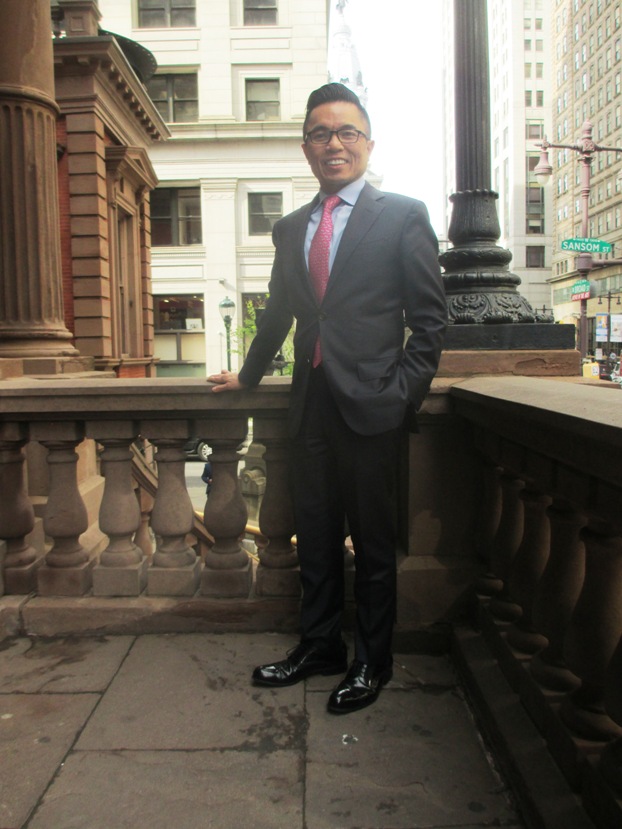
E-ZPass: Making Life EZ-er
When this writer’s young son first hears the “you kids don’t know how good you have it” speech from Dad, you can bet E-ZPass will be part of the conversation.
“Transponder? Heck, we didn’t even know what a ‘trans-pond-er’ was! Back in those days you dug into your pockets for that extra quarter ’cause the rates went up all the time, and you had to sit there waiting at the booth for hours, and then you had to hand your cash over to that guy who always dropped your change on the ground! Plus you had all those people asking directions while you’re waiting, like them toll takers are AAA or somethin’! You kids today ain’t got no idea what it’s like to be searching for a dime on the floor while you’re…look at me when I’m talking to you, son.”
Yes sir, those were the good old days.
Making the switch from stopping at booths and dropping exact change in baskets to using E-ZPass to fly through a toll plaza is one of those “why did I put up with that for so long” moments in life. That little white tablet stuck to your windshield opens up a whole new world.
Suddenly getting off of the Pennsylvania Turnpike temporarily for a break or a bite to eat is a more viable option, since you no longer have to dig out a few bucks and sit at a toll booth yet one more time. An empty pocket no longer stops you from using a toll road as an alternative to a jammed freeway. Tolls for E-ZPass users are less expensive in peak times, and now using the pay as you go road for the length of a long trip isn’t such an expensive idea.
Not to mention that little bit about how we don’t have to sit and wait at tollbooths anymore.
Tae Seangpeoam, founder of Neztec Solutions, is one of the people we can thank for the considerable road stress reduction from that little invention. Seangpeoam was a senior network engineer for MFS Technologies (bought out by MCI WorldCom that year) when the company was called on to improve a promising but fledgling electronic toll system.
As he sat on a sofa at the Philadelphia Union League where we conducted the interview, he clearly enjoyed the trip down a toll-free memory lane.
“I had just come out from college,” Seangpeoam remembers. “I was almost the youngest one on the team. I was so excited, they were saying it was going to be the project of a lifetime. When you’re young, to prove yourself, you do it. I was lucky.
“E-ZPass started in 1980, the idea. But it was never successful anywhere. There were many failures due to design, engineering, and government agencies. The project would never go anywhere because it kept collapsing between authorities. My responsibility, as a senior network engineer, was to design the architecture for the telecommunication; the communication between all of the toll booths going back to New York, to the violation process center, and to the customer service center.
“During that time the main problem was billing. Sometimes it would detect an axle, sometimes not, sometimes it wouldn’t detect your license plate. The camera was not clear, it couldn’t read clearly. The system didn’t know how to match that, and it would send a wrong bill or something. Back in those days, each toll booth didn’t have anything at all. It was just bare bones toll booths. Atlantic City Expressway, Garden State Parkway, they just had manual booths.
“We went in, took a look and surveyed everything, can feed a fiber optic line through that, or are we gonna do something else? We put satellites in several locations around Atlantic City. We did all that to link the communications back. All the transactions from the toll booth link back to the center to process, every transaction at the toll booth links back to the main frame. Also the security aspect…we had to make sure that the firewall and every single thing under the sensor is protected.”
“When we launched in Delaware, it was a tremendous success. All the toll booths were connecting to each other throughout New Jersey and Delaware, all the transactions were processed at the Violation Process Center and Customer Service Center, all the tags and transponder were communicating to the system, censor and lighting, backup video record, etc.
“The whole project was about three years; then I left the company and went to work for Verizon. I have a passion about communication; every single thing about it.”

It works so well we’ll use it in every lane.
So when you sail through the E-ZPass express lane, is there a camera taking a picture of your car and sending it to E-ZPass Mission Control to fire off the bill in the mail? Well, yes, that’s sort of what happens. But there is, of course, more to it than that.
As Seangpeoam explains, the transponder on your car connects with a sensor at the toll booth, and it sends a signal that the car with your ID is approaching. As your car is passing through, E-ZPass completes an entire profile on it…the type of car, how many axles, who owns the transponder, etc. Seangpeoam says it all has to jibe, especially the number of axles.
“If you look down the road at the toll booth, you’ll see the sensor of the treadle, to tell if your vehicle is a two-wheel, four-wheel, sixteen-wheel and so on. Those need to match to whatever the camera sees. The tag sends the signal that the car is coming, that’s what goes through the transponder. But it also sends a signal to another interface behind the scenes, to make sure that matches your transaction, because otherwise it could be a motorcycle or whatever.
Does that mean you really shouldn’t be using your transponder in your wife’s car? “You can use it in your wife’s car, but legally that’s a violation.”
This writer hasn’t yet tried that with his own tag, but Seangpeoam assures me that this contingency had been considered by the network people. “You’ll get the bill,” he says.
Today Seangpeoam runs the show at Neztec Solutions. His services, according to his business card, include real-time messaging, visual communications, and safety/compliance.
“In the past 10-15 years, you’ve started to see the global economy growing,” he explains, “And every single business has to deal with rules and regulations and compliance. That becomes really complex, and it is getting more and more complex. Even the small business has to deal with certain types of compliance and regulation.
“No matter what you do, no matter how good the things you come up with, communication is always the bottom line of the process. You’ve got A, you’ve got B, how are they going to communicate?”
Has the E-ZPass experience, especially persuading state governments to cooperate with each other, given him street smarts? “Absolutely. I wouldn’t be where I am now without that knowledge.”
He’s still today pleased with the results of the system he helped design. As he should be. Imagine I-295 today on Thanksgiving weekend, he says, how backed up the toll booths would be, say, at the Delaware Memorial Bridge. No thanks.
“I am really proud in what I have contributed to my adopted country. I was lucky enough to be part of wonderful projects; it gave me foresight to build a career around my life, and see the future of transportation, roadways, bridges and tunnels, and infrastructure communications.”
“Less time, less energy, less frustration, people are happier, more productivity for sure. You get to your destination faster, and with less stress.
I’m proud of that because again, the purpose of communications is to take society to the next level. If you want to make a phone call right now, you push the number and it’s gonna ring on the other side. The devil is in the details no one sees, everything on the surface is very simple, very easy, but that’s why an engineer like me loves it. I love to go behind the scenes and see what makes things happen without people knowing it.
“I’m a technology guy. I love technology. However, I don’t believe in technology that comes out and makes people learn how to use it. E-ZPass is the only technology in the past 15, 20 years or whatever, do you need to learn how to use it? No. You just slap it on the windshield and go. Even kids know how to use it, because it doesn’t require you to learn anything.
“That’s what technology is supposed to do.”
Hope you enjoyed this article about E-ZPass and its impact…
If you did, I would really appreciate your support.
When you use this link to shop on Amazon, you’ll help subsidize this great website…at no extra charge to you.
Thanks very much…come back soon!

The Resilient Reading Terminal Market

The Reading Terminal Market in Philadelphia had its struggles in 2020, so JerseyMan and I gave it some well-deserved props for the January 2021 issue. You can see it on JerseyMan’s website here, or see the magazine article here.

The Resilient Terminal Market
The Reading Terminal Market was hit hard by the pandemic, losing over half its foot traffic throughout the tourist season in 2020. The merchants, locals, and even some outsiders came together to help keep the lights on, but the quality of the goods is ultimately what keeps the Market going.
A visit to the Reading Terminal Market is well worth any travel expense and hassle, but it always presents an exasperating conundrum:
“What the hell am I gonna eat?”
Human stomachs are insufficiently sized enough that in every trip to Philly’s venerable marketplace, it’s impossible not to miss out on something amazing. It’s particularly rough for tourists, who may only manage one or two visits.
The Market sometimes seems to cause more culinary heartache than pleasure. Sure, have one or three of Beiler’s doughnuts…but unless you have a committed sweet tooth, that means foregoing Dutch Eating Place apple dumplings, Flying Monkey whoopie pies, or Termini Bros. torrones.
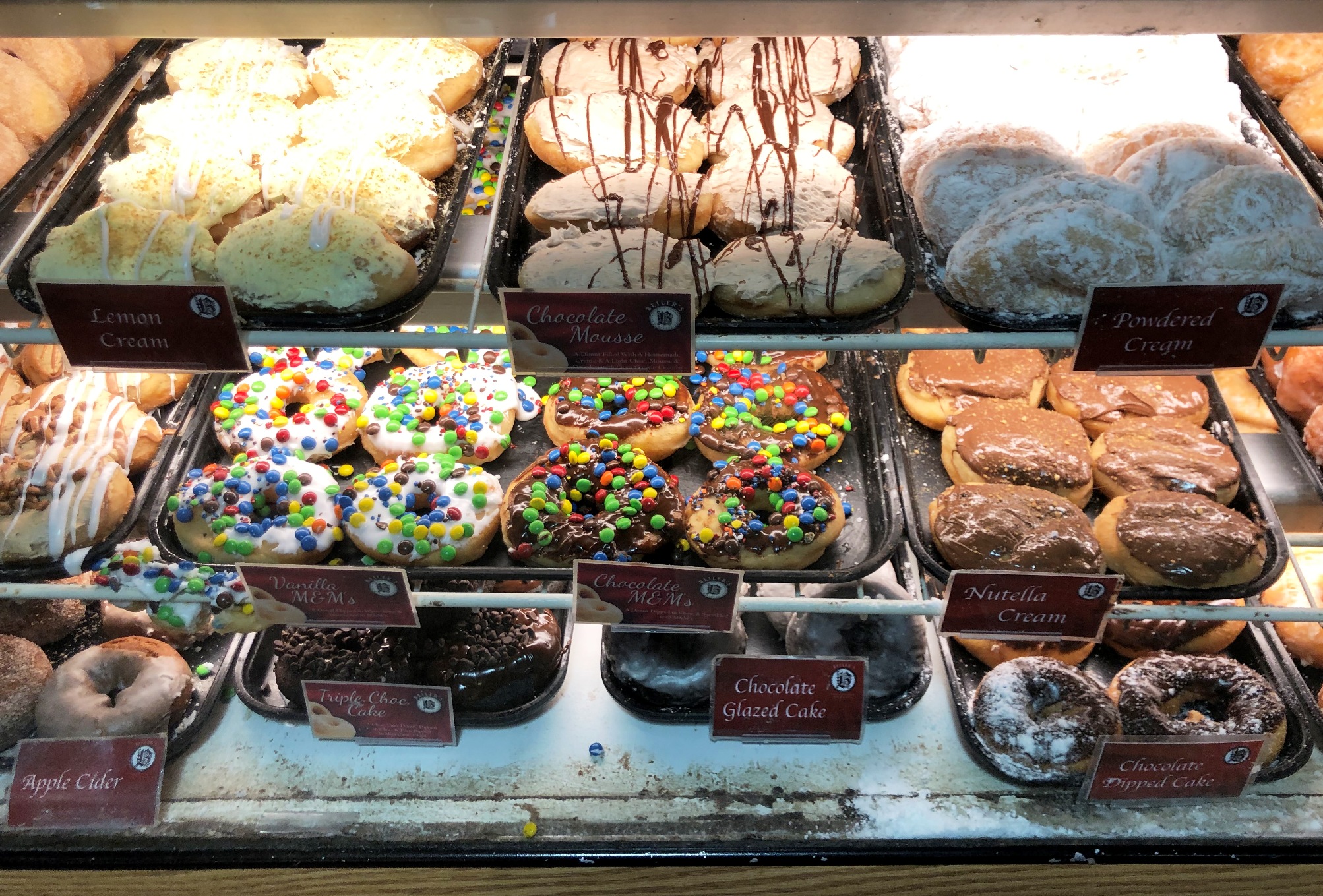
Sorry, what were those other choices again?
If you’ve ever experienced this distress, you’re not alone.
You’d think the Market’s general manager would have sound advice for this situation, but unfortunately Conor Murphy isn’t much help. Murphy visits the Market every day, and even he struggles mightily with the question.
“There’s just so many great sandwich options,” he says. “You’ve got a fantastic sandwich at Smucker’s, DiNic’s is obviously incredible. I’m an unapologetic carnivore, but there’s great sandwiches too at Luhv Vegan. Whether you want a chicken sandwich or a beef sandwich or a fresh deli sandwich…Hatville Deli does a great job…there’s just too many choices almost.
“It can be a challenge sometimes to choose your lunch. Phenomenal options, the classic Philadelphia specials, and also obviously great healthy options too.”
London Faust is the digital media manager at Bellevue Communications, the firm that manages the Market’s PR. She is a bit more willing to risk choosing a go-to vendor; she recommends Olympia Gyro.
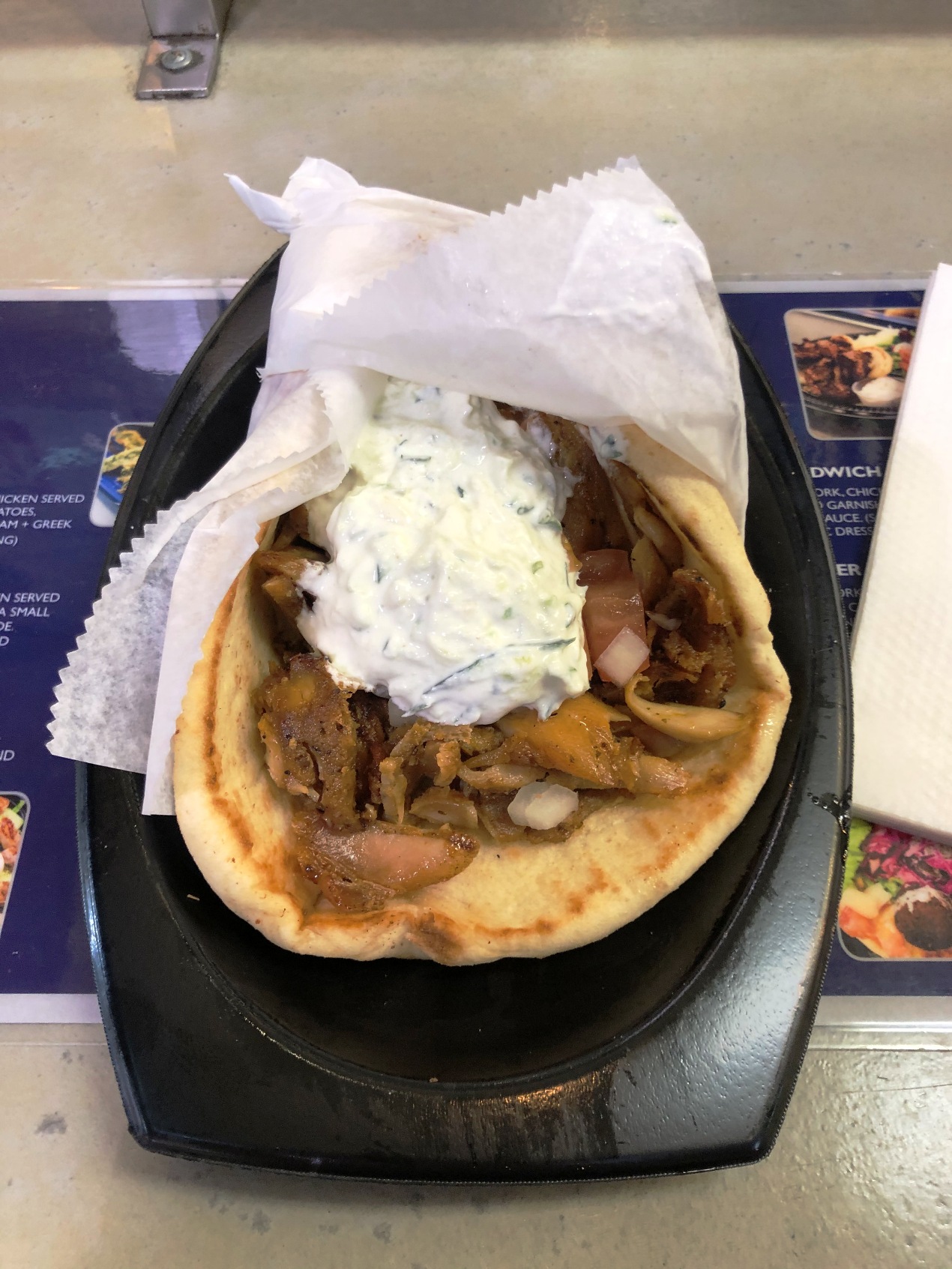
Just for the record, she’s right.
“It’s well balanced and a good bang for your buck,” she shares. “Their gyros are really good and fresh, and don’t fill you up to the point where you’re so uncomfortably full, but they also have the biggest, freshest salads I’ve ever seen.”
Okay, that helps a bit. Murphy also offers a small but valuable piece of advice: Don’t look over your shoulder.
“Sometimes if you’re standing at DiNic’s, and then you look over your shoulder and you see Hershel’s, well then suddenly the decision just became much harder. You go to Olympia where London likes to go, and you turn over your shoulder and there’s Kamal’s.
“You kind of have to come in with your blinkers on almost. Make your decision and get it done. Because if you turn your shoulder, you might have to change your mind.”
This extreme gastronomic agitation is the true appeal of the Reading Terminal Market. For locals, the substantial selection of food staples keeps one returning, again and again. For frustrated tourists, it may inspire a better-planned return visit to Philadelphia. The Market is equal parts tourist attraction and favorite local destination, and it does both very, very well.
That balance has been key to its survival in the toughest of times. Which 2020 unquestionably was.

We will get through this, for the Market’s sake.
(photo courtesy of the Reading Terminal Market)
Throughout the history of the Reading Terminal Market, it seems to have been positioned to survive world instability. That doesn’t just include a depression and two world wars. The Market has weathered other storms too, like the decline of the railroad industry.
The “Reading Terminal” part of the name comes from its location, as a key hub for the Reading Railroad. The rise of the automobile drove the Railroad into bankruptcy by 1971. The Reading Company remained overseeing the Market, but they instituted higher rents for already struggling merchants, driving many of them away.
Decline and crumbling infrastructure continued until the Convention Center Authority purchased the Market in 1990. With that deal came $30 million of public funding for upgrades. To secure that kind of cash, you’ve probably got some clout with the locals.
So where does a worldwide pandemic rank among the tribulations the Market’s endured in its 128 years?
It’s probably top three.

People never stay away from Bassett’s because of the quality of the ice cream.
“The Market has been through a lot,” Murphy says. “But I’m looking back through history, talking to different merchants and historians, and there’s a general sense that this is certainly up there with those past experiences.
“Usually from April through Thanksgiving, food and beverage options around the city get a lot of foot traffic. On a Friday or Saturday the Market would have anything from 35-40,000 people a day coming through. This year, it was anything from 55-60% drop in those numbers.”
The difficulty of social distancing in a tight city venue doesn’t help. “As an old train station, you can imagine the building is equipped for lots of people coming through,” Murphy adds.
Like every establishment in the country, the merchants have had to adapt to survive. But just as every difficult period in our history has revealed the strength of the Market, the challenging times caused folks to rally behind Philadelphia’s favorite food destination.
Even from as far as Boston.
As efforts grew to help the Market stay operational, including adding a GoFundMe page, it attracted the attention of Dave Portnoy, founder of Barstool Sports. Despite being a Beantown area native, Portnoy is a Philly food enthusiast and passionate about supporting the cause. He arranged for Penn National, the owner of Barstool Sports, to donate $100 for every $100 deposit made by fans in the Barstool Sportsbook app.
It was a significant factor in the GoFundMe campaign’s success, which has totaled $211,597 as this sentence was written, contributed by 4,773 Market fans. The funds will be enormously helpful for day-to-day operations.
“Since the beginning of the pandemic,” Murphy explains, “we’ve offered support to merchants in the form of rent deferments. One of the other things that we do a lot is events, and we are able to cover a lot of our costs through some of those events. So without the events, and with some deferments in place for merchants, we wanted to make sure we were able to remain available and open seven days a week.
“Simple things, being able to pay utility bills, and all the extra sanitation costs that we now have to keep customers safe.”

Keep the lights on for Hershel’s sandwiches.
Murphy is overwhelmingly appreciative at the reminder of how beloved the Market and its peddlers really are.
“The Market has such an incredible presence for everyone that lives in the city,” he says. “Some of the personal stories were really, really fantastic. I think ultimately the Market is here because of Philadelphia, and because of the loyalty that shoppers have to us.”
Speaking of what he calls the camaraderie and spirit of the Market, you can hear the emotion in Murphy’s voice.
“With the essential service designation for public markets…nobody at the Market had to be told what that meant. They all just love to serve people. They fundamentally understand what it means to serve customers.
“I grew up in a small business in Ireland. People who run small businesses, they’ll always be my first heroes. They’re just fantastic people, you know, they really are. Small business is so, so important, especially now.
“I moved here six and a half years ago, and it’s amazing to see how people have been so supportive. It’s fantastic to see Philadelphians wanting to support the Market so much.”
Faust shares Murphy’s reverence for the outpouring of civic pride. “The Market’s really a family,” she adds, “and it’s really heartwarming to see everybody support each other.”

By George, I think I’ll have some pizza!
While 2020 was as tough on our favorite marketplace as it was on everyone, the difficulties may ultimately become growth opportunities. Murphy says merchants have greatly improved their ability to take online orders and deliver the goods for hungry fans. The virus may have revealed how much these iconic vendors underestimated their popularity outside of the building.
“We have worked really hard to get people onto delivery platforms. We’ve got a great partner, Mercato, that helps us on the food delivery side. Then the lunch counter merchants, trying to pivot their businesses to delivery apps, the Caviars and the Doordashes of this world.”
Murphy admits, however, that the ability to order delivery from so many wonderful vendors can’t match actually visiting a Market so abounding with edible excellence that you can’t even look over your shoulder. That exasperating whirlwind moment of indecision between Carmen’s and Keven Parker’s is the Reading Terminal Market at its alluring best.
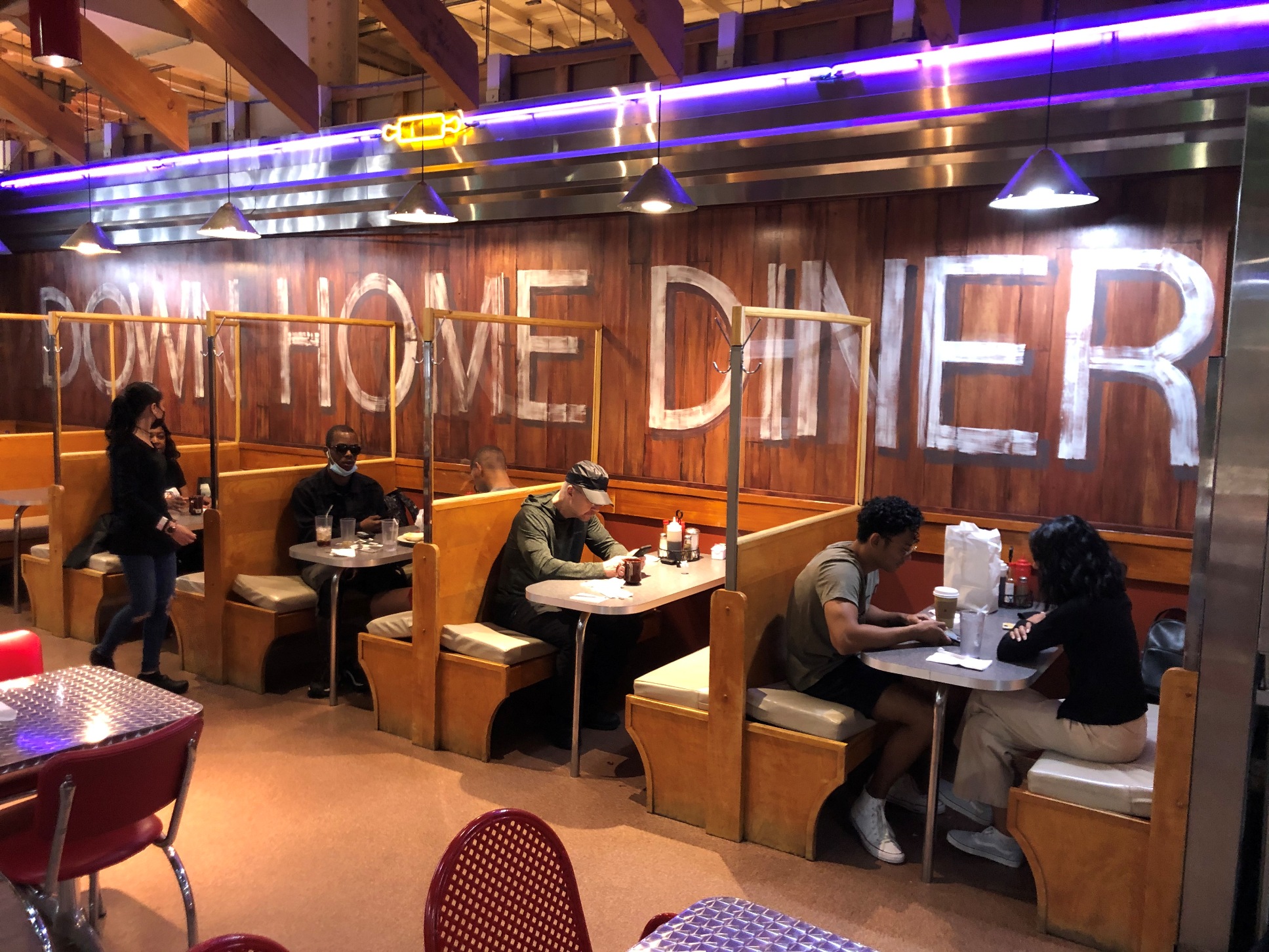
Social distancing is worth enduring for down home cooking.
“Pandemics end,” Murphy reflects, “and I think there is some light at the end of the tunnel with all the great news recently about vaccines. The best experience of the Reading Terminal Market is to come and visit us yourself. Ultimately, what we love to see here is people come through our doors to visit, because it is such a great food experience.”
That it is, even if it’s a torturous dilemma to choose from dozens of world-class eateries. Fortunately, Murphy is confident we’ll have many more opportunities to experience it all.
“There’s obviously a very clear love for the Market. That love has been built over 128 years, and our plan is to build it for 128 more.”
And Down Home Diner’s scrapple alone could keep us coming back until 2149.
Did this post make your day a little bit?
I hope so. If it did, I would really appreciate your support.
When you use this link to shop on Amazon, you’ll help subsidize this great website…at no extra charge to you.
Thanks very much…come back soon!

The Market has all you need.
(photo courtesy of Carolyn Wyman)
The Market Sampling Tour
The Taste of Philly Food Tour people can help you a tiny bit with the agonizing challenge of what to get at the Market. You can book an inexpensive tour of the Market on Taste of Philly Food Tour’s website, although as of this writing tours are still suspended.
Author Carolyn Wyman runs the site and tour, and she knows a bit about food in our fair city. She’s the author of The Great Philly Cheesesteak Book, the definitive guide to classic vendors of Philly’s signature sandwich. The very well done book even mentions 2004 presidential candidate John Kerry’s costly cheesesteak faux pas.
The tour is not actually through Philadelphia but is simply a tour of the Market itself; Carolyn or one of her friends leads visitors through the Market and shares stories of its history…along with, of course, tastings.

Miller’s pretzel cheesesteak anyone?
According to Wyman, samples that patrons get to try (based on group size and dietary issues) can include:
– A piece of a Miller’s Twist pretzel
– Scrapple from Down Home Diner or Dutch Eating Place
– Snapping turtle soup from Pearl’s Oyster Bar
– Butter cake from the Flying Monkey Bakery
– Jewish apple cake from Hershel’s deli
– Butterscotch vanilla ice cream from Bassett’s
– Wilbur Buds and Goldenberg Peanut Chews from the PA General Store.
Wyman adds, “The tour definitely includes ideas on other great foods and best finds in the Market…the most popular donut at Beiler’s, the unique Philly cream cheese cheesesteak at Carmen’s, the summer-only lemon cooler cake at Termini’s etc.”
Certainly enough to assist in that blasted decision process, and samples are small enough that you’ll still have room to order a full version of what you liked the most.
The Market’s website calls it “fun history that has nothing to do with government”. Something to consider for the next field trip with the kids.
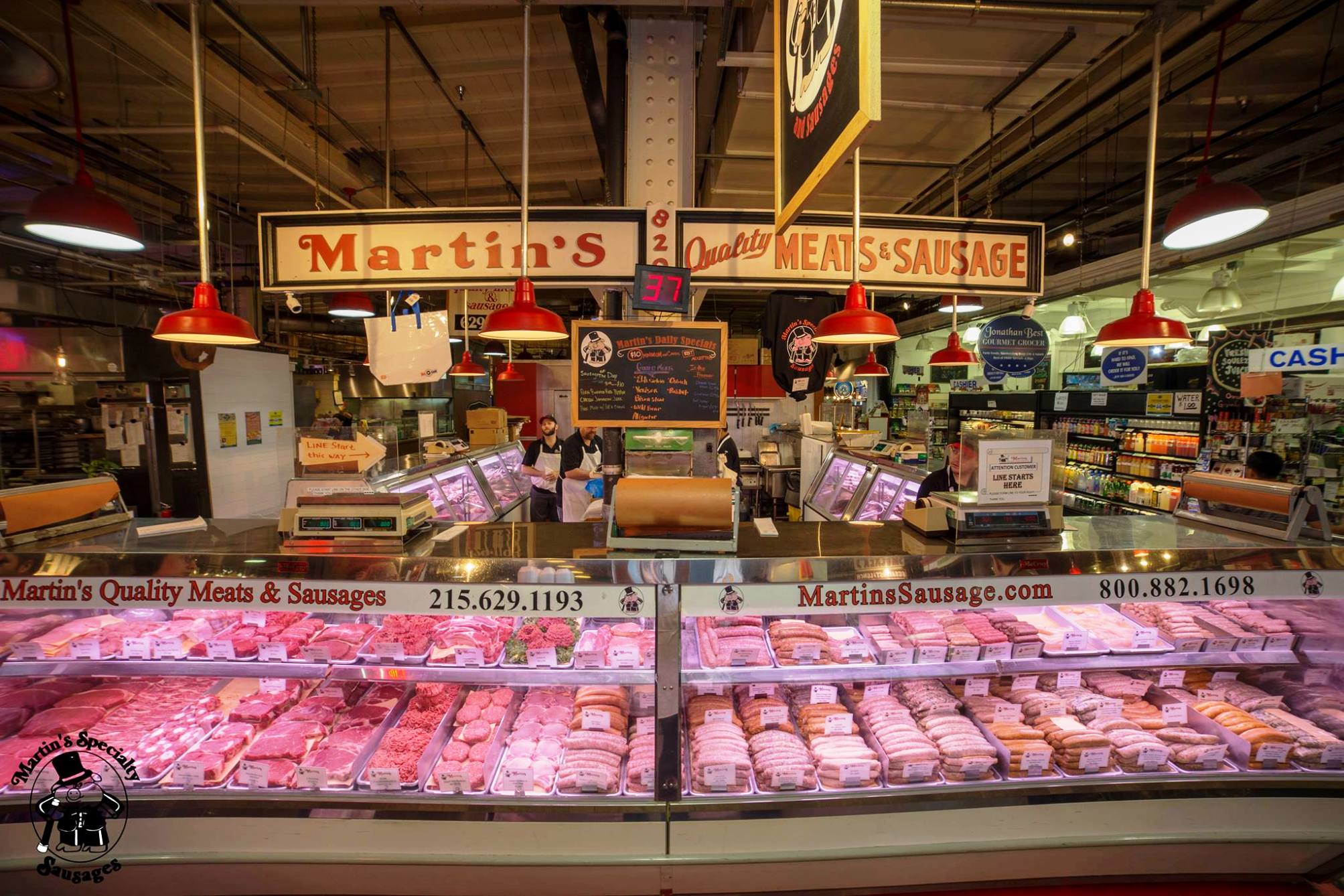
I looked behind the counter. Diane Kruger wasn’t there.
(photo courtesy of Martin’s)
A True National Treasure
The Market has made a few appearances in American cinema, most notably in the 2004 hit National Treasure.
You may remember the scene: Abigail (Diane Kruger) and Riley (Justin Bartha) temporarily escape from villain Ian Howe’s (Sean Bean) henchmen in the Market, and Abigail temporarily hides behind the counter of Martin’s Quality Meats. The woman working behind the counter, after initially informing Abigail that she doesn’t belong there if she’s not a steak, lets her stay believing that she’s running from her ex-husband.
The movie crew brought in close to 50 extras to pose as customers (the woman behind the counter was an actress named Sharon Wilkins) and spent 14 hours on two Sundays filming the scene. Gabrielle Giunta, daughter of Martin’s owner Martin Giunta, told JerseyMan about it.
“The market was closed on Sundays, and they asked us to open and set the case on a Sunday to do the filming. The producer put an actress behind the counter for ‘customer service’ and they had to film the scene a bunch to get it right.
“A lot of people did ask us about that in passing – was pretty cool as a kid to hear people ask my dad about being in National Treasure.”
The chase scene, like the rest of the movie, turned out superbly. But the movie makers seriously screwed the pooch on feeding the crew. They brought in a trailer from an outside caterer, rather than letting the crew dine on the countless offerings from the Market itself.
If you’ve never seen the movie, you can view the scene on YouTube. (But check out the whole movie…it’s good.)
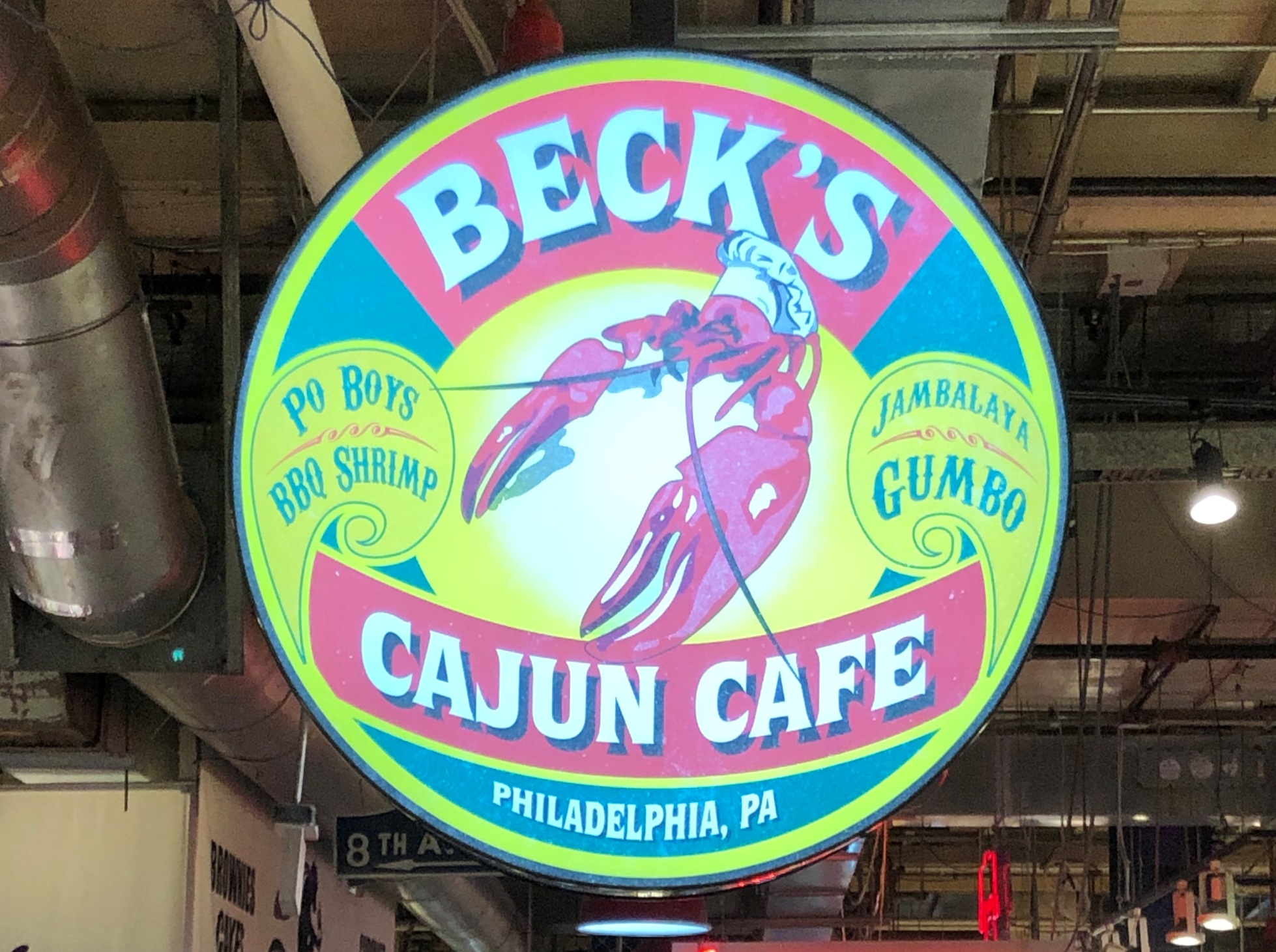
Now delivering to your area!
Bringing The Market To You
As Conor Murphy points out, the Market has partnered with Mercato, the online grocery delivery service. Thanks in part to the pandemic, you can now order food from most any Reading Terminal Market merchant, and have it delivered within a reasonable radius.
Be warned; the process of choosing isn’t any easier…but at least you can take some time to think about it. The merchants’ logos are featured in a rotating slider, enabling you to choose one and view their delivery offerings. Order a blackened chicken platter from Beck’s Cajun Café, a vegetable lasagna from By George, and a pound of smoked wings from Dienner’s. Add three chocolate swirl banana puddings from Sweet Nina’s for dessert, and you’ve got a few days’ worth of fantastic food in the comfort of your own digs.
It’s not cheap; the shopping excursion just described will set you back just over $75 if you’re sending it to Turnersville. But it spares you the gas, tolls, parking, and travel time, and Mercato will bring the fabulous flavors of the Market to your front door. Mercato offers discounted delivery when you join their Green service.
It’s a great way to experience the Market without leaving your home, which, as we’ve all recently learned, is something that could afflict anyone.
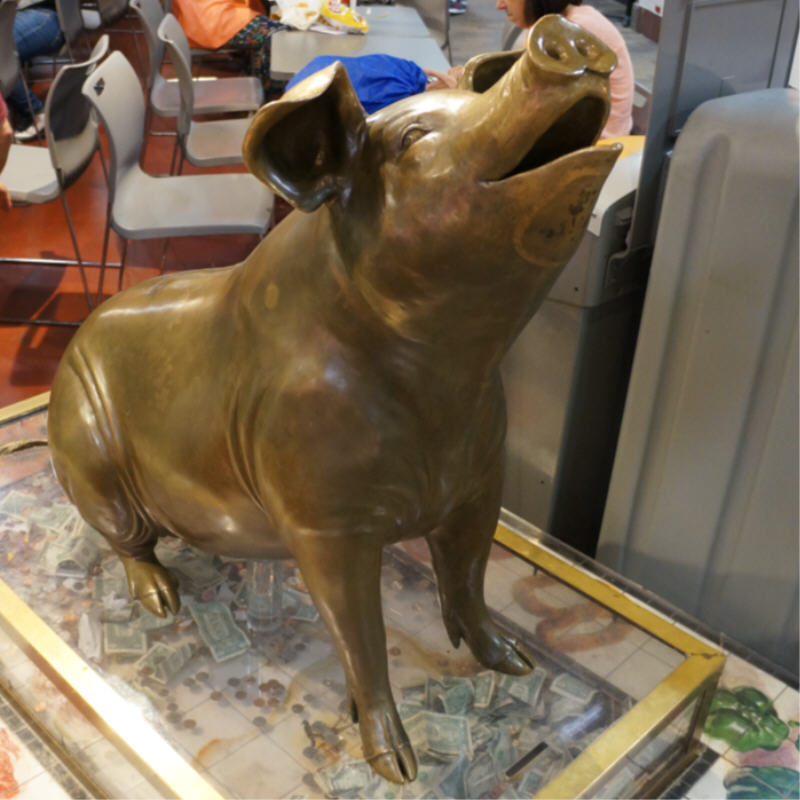
The ever-pleasant Philbert, collecting money for the hungry in Philly’s favorite food market.
(photo courtesy of London Faust)
Philbert, The Reading Terminal Market Mascot
If you’ve visited the Market, you may or may not have noticed Philbert, the life-sized pig statue that sits on a box of coins in the center of the market. Philbert is named for Filbert Street, one of the streets adjoining the Market.
Philbert was sculpted by Eric Berg, who passed away of heart disease in May of 2020, at the age of 74. Other Berg structures in the city include the Drexel dragon, the panda at the Children’s Hospital, and the African Warthog at the Philadelphia Zoo. You can view his impressive body of work here.
In addition to being a popular Market meeting spot, Philbert is in fact a piggy bank; visitors can drop coins in its mouth, which eventually lands in the glass box on which Philbert sits. The money in the box is then donated to a different charitable organization each month, as determined by the Philly Food Trust.
You can rub his snout for good luck too, as many do; maybe it will help you make that all-important food choice at the market.
Source: Atlas Obscura

Staying Green – ex-Patriots Champion Jarvis Green

I interviewed two-time Super Bowl champion and ex-Patriots defensive end Jarvis Green for the Winter 2021 issue of BostonMan. You can read the magazine edition here, or click here to read it on BostonMan’s website. Enjoy.
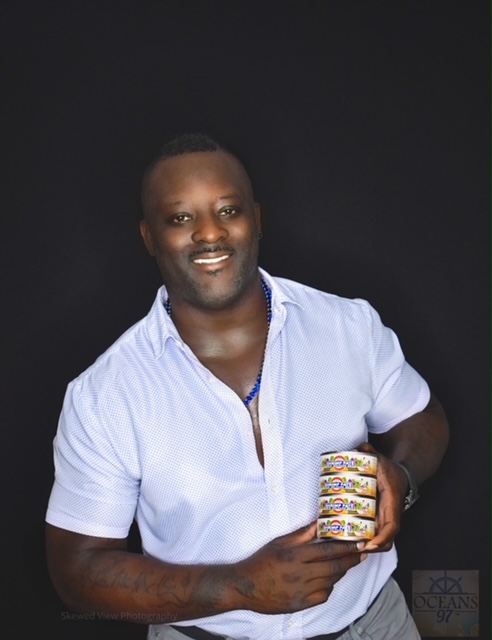
Former Patriots defensive end and 2x Super Bowl Champion Jarvis Green, with his canned shrimp pate. (photo courtesy of Jarvis Green)
Staying Green
After eight seasons with the Patriots and two Super Bowl rings, defensive end Jarvis Green is growing a business selling his superb canned shrimp pate in the New England region he loves. In the age of Covid-19, he’s managed to do pretty well meeting the needs for PPE too. BostonMan caught up with Green to talk about his football career, his successes in business, and being a part of the Patriots family.
Jarvis Green didn’t exactly part ways with Bill Belichick and the Patriots on the best of terms.
The two-time Super Bowl champion defensive end, who’d finished the 2009 season with 36 tackles and a sack, was offered a four-year extension from the Patriots. He turned it down.
The move is on his small list of regrets.
“I should have took it,” he reflects. “My sports agent, he got into it with Belichick. It was more or less, you know, you should fire your agent. I can’t get into details, but a lot of s*** happened between Belichick and Denver.”
You might not think it was the worst move on his part at the time. He was, after all, offered more money to go to Denver than many of us will make in our lifetimes. Denver isn’t an awful place to live in or to be a pro athlete. And he knew Broncos coach Josh McDaniels, the Pats’ former (and now current) offensive coordinator.
But Green, who is prone to using colorful language in an entertaining way, describes his short stint in Denver as a “s***show”.
It started out promising. After having stem cell work done on his deteriorating knee, he was having the training camp of his life.
“When I went in the off season, I was number one. When we used to practice these one-on-ones, I was the one who’d get the best guy on the Denver team. I get him lined up, I kill him! I remember calling Pepper Johnson, saying this is my best off season ever. I’m killing these guys. They can’t even keep up with me.
“I go in to training camp, I’m the sixth string D-line man. I’m like, what the hell just happened? But they knew. They saw my knee kind of tripping in film. They saw that I had something going on with my knee.”
Still, he was rightly displeased at a demotion without warning or explanation. “I got released the day before cut day. When I left, I didn’t say bye to anyone.”
After similar fruitless visits with the Browns and Texans…Green describes his three weeks in Texas as a vacation…he “limped out of the office” in Houston and retired.

Green lays a hit on Big Ben.
(photo courtesy of the New England Patriots)
Jarvis Green frequently gets asked who the leaders were in the locker room of those great Patriots teams. His answer makes clear what made Belichick’s Pats one of the great dynasties in professional sports: everyone.
“Everybody was leaders, man. I’ve been to Denver, I’ve been to Houston, everybody’s waiting for one guy to show up. In New England, we had everybody pushing, trying to get in front to say, who’s going to say this, or who’s going to do this, who’s going to make the play first.
“I remember when Junior Seau came in. It was so funny because he was a guy that wanted to be on top of the soap box and give out his three, four minutes, you know? I remember I could see the guys, we just kind of grin and give him his throne.
“That’s the type of tradition we had.”

Green can cook up some shrimp.
(photo courtesy of Jarvis Green)
Oceans 97’s Amazon entry for hickory smoked shrimp pate describes it as being keto-friendly, made with only natural ingredients, and a versatile product that can be eaten straight out of the can, or on vegetables or crackers.
There’s no mention of the dedication of Oceans 97’s founder, or a picture of his New England-famous face. You have to visit the website for that.
Being on a two-time championship squad may have pushed him to set a higher standard for himself. Maybe that’s how he stayed on that squad. But Jarvis Green is dedicated like that, and he proved it again in life after football.
He decided to go into the shrimping business as a favor to a friend. After buying a boat that he christened “Jenny”, he sang with the choir in church every weekend until a hurricane wiped out every boat but his.
Okay, that last paragraph is bunk, except for the bit about going into the shrimp business for a friend. Green is well aware of the parallels to Forrest Gump. Don’t call him Bubba. Like Forrest, Green knew nothing about the shrimp business.
Given his status as a Super Bowl champion, he could have simply lent his face, name, and uniform number to Oceans 97, the company he started.
But knowing that having his visage on a website wouldn’t improve the product’s taste, he dove deep and learned the business. The hard way. Green is a proud native of South Louisiana who knows the importance of quality food and its role in good times. He wanted his shrimp product to be the best it could be, because “people are going to create s*** all the time. It’s hard to sell s***.”
The two time champion multi-millionaire endured a six month internship in the world of shrimping. He even took on a broom and a mop in the factory. (Imagine handing a 6-foot-3, 285-pound defensive lineman a broom. Someone there has some brass ones.)
“We had a factory of like 90 people. I remember, I’m the tallest person looking across the factory. We’ve got about 50 people, peeling shrimp, eight hours, ten hours at a time. I was on that line, peeling and de-veining shrimp with my hand, and understanding that it’s a certain process, the way you procure the shrimp, you peel it, you rinse it, you freeze it, you package it. And it makes a difference, you know?
“That’s the biggest thing about having the right quality shrimp. It’s the supply chain.”
Oceans 97’s supply chain, Green confidently asserts, is “super tight”. He had landed multiple deals with local markets, and had several larger deals in place when a blasted virus changed the world. Green’s story is one of the lesser told stories about the impact of Covid…the devastating damage to businesses from lockdowns.
“I had got just approved with our Hong Kong market. Hong Kong Island, with a company called Food Wise and another 2,000-plus distributors of stores. I had that and I had another, and I’m working on some other more independent retailers in the South.
“I had that kind of set up and Covid hit. Can’t do demos anymore, Hong Kong canceled, corrections canceled, a few of the independent guys canceled because it’s a new product, right? They said we’re going to buy what we typically buy, buying a new product’s going to be kind of hard. You can’t do demos.”
Many established entrepreneurs could probably tell you a similar story. Not very many could say how they turned it all into a net gain.
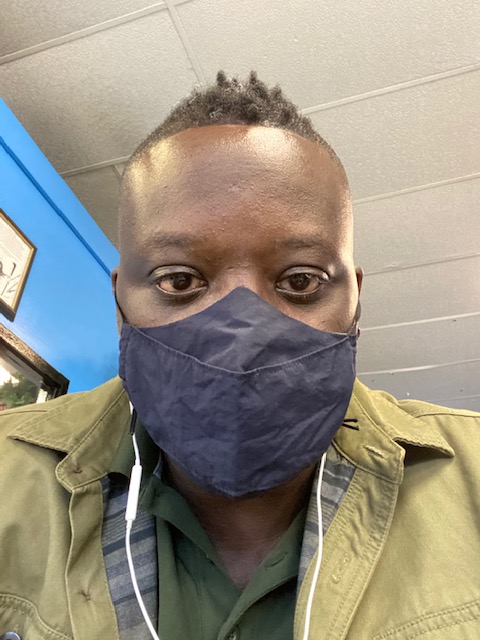
Helping you to stay safe.
(photo courtesy of Jarvis Green)
After a few of his ongoing deals fell through, including with a corrections facility in Louisiana where Green lives, he found himself in the “what now” state that so many entrepreneurs faced in 2020. That’s when the corrections facility he was working with asked him if he could supply hand sanitizer.
“Covid hit, locked down New Orleans, limit this, limit that, limit limit limit. I remember I wasn’t looking for this, but then my corrections guy was like, ‘Hey Jarvis, could you help me get some sanitizer, figure out how to get some sanitizer for the inmates?’
“I have no idea. I don’t know the first thing about sanitizer. I started doing research, calling some people. A friend of mine had another friend, he knew someone who had some spirits company in the mountain, west, whatever area. I helped my guy with some stuff in the corrections.
“I started looking into some stuff, and I won a bid with the state of Louisiana for sanitizer. I won some masks bids with Louisiana, and then I won a huge proposal deal with the Tennessee National Guard.
“I won the bids, made a ton of money. I made more money in those two months than I made with my shrimp business in the last five years. You can put that on paper. It’s just been crazy and I’m still doing that now.”
They may be wholly unrelated businesses, but Green credits his education in the shrimping business “big time” for his success in the world of PPE distribution.
“The biggest thing is about being patient and to find the deals, because every deal’s not for you. I’ve lost some great friends, because everybody’s playing octopus and has got ten different deals that they thought were real and weren’t real at all.
“I got my counsel involved, and I separated from all the different deals. I stopped dealing with all of these agents and buyers. We started working with the factories in China directly. The biggest thing right now is price gouging. The things we’re selling, we’re not price gouging, and we’re selling a competitive product through great sources.
“This is what I tell people. When I got into the shrimp business, it taught me how to understand international trade, international business. Dealing with different companies, dealing with banks, understanding LCs and different jargon, just to get business done abroad.”

Just as tough in a red shirt.
(photo courtesy of the New England Patriots)
Throughout his football career, Jarvis Green dealt with severely debilitating back pain. Even to this day, he says, he is strongly encouraged to have back surgery.
“My spine doctor, they call me twice a year. In 2014, they wanted to rush and give me surgery. They wanted to give me fusion, L3, L5 fusion, six points, all this bulls***.
“I didn’t want to do it, because my Dad had 17 back surgeries. He shakes like a leaf. He’s a veteran, he has a wheelchair. He has all kinds of s***, he broke his back with a job back in ‘79.
“My dad always said, I don’t care what you have to do. Don’t ever let anybody touch your back. Deal with the pain, it’s going to be much better than going through surgery because you’ll never be the same person again.”
Green deals with the pain, through highs and lows on the football field, in business, and in his personal life. Today, of all his considerable accomplishments, he is proudest that he’s still the same guy.
He unexpectedly learned that the local football team, with whom he went to the top of the mountain twice, felt the same way about him.
After some years of hard feelings, Green is currently an ambassador with the Patriots again, making appearances and occasionally going on trips with the club.
Mending the broken fences following his contentious departure, it turned out, wasn’t as difficult as he thought.
“It took three years for that to happen,” he says. “The Patriots were playing the Saints. Home game for the Patriots, right? I went to the game, I had the throwback jersey on, #97. I’m just a fan, I bought my ticket. I just went to the game, enjoyed myself and went home.
“So I’m thinking this just the way it is when you retire, they don’t give a s*** about anybody. That was my mentality, right?
“I’m in the stands, and they caught my picture on the Jumbotron when I was eating popcorn. Before that, I heard people behind me saying, why’s this guy got a Jarvis Green jersey on? They didn’t know who I was. After that, people come to me asking for autographs.
“I got a call from Pepper Johnson, or a text. He said, ‘Hey, what are you doing? You at the stadium?’ And then somebody said, hey, they want you to come down into the operations the next day.
“This is three years apart from the beef, you know, the Belichick situation, me and my sports agent, going to Denver, getting cut, all this s***. And I’m like nervous as hell. Won two Super Bowls with this team, now nervous as hell. I remember walking in and right when I walked in, I think I saw Tom first.
“I was there for like two and a half hours, just going through, saying hey to everybody. I remember talking to Josh in the cafeteria, just me and him at the table. Just saying, it’s business, things happen, back was against the wall, do what he had to do and pretty much a shake and a hug.
“It was very emotional, seeing all those guys. You know, eight years is a long time in the football world to be under one team, one organization. I appreciate Coach Belichick, to let me come in there.
“That’s kind of how everything got back. You know, they say, hey, you’re okay.”
In the interview for BostonMan, Green speaks slowest and pauses the most when speaking of his former coach’s words to him that day.
“Now this was the biggest part. After I was leaving, I’m walking out, drowning some of my tears. Belichick walks out, he says, ‘Hey Jarvis, remember, you’re always gonna be family here. You were a part of all of this.’
“He said, ‘Never be a stranger. You’re family.’”
Did this post about Jarvis Green make your day a little bit?
I hope so. If it did, I would really appreciate your support.
When you use this link to shop on Amazon, you’ll help subsidize this great website…at no extra charge to you.
Thanks very much…come back soon!
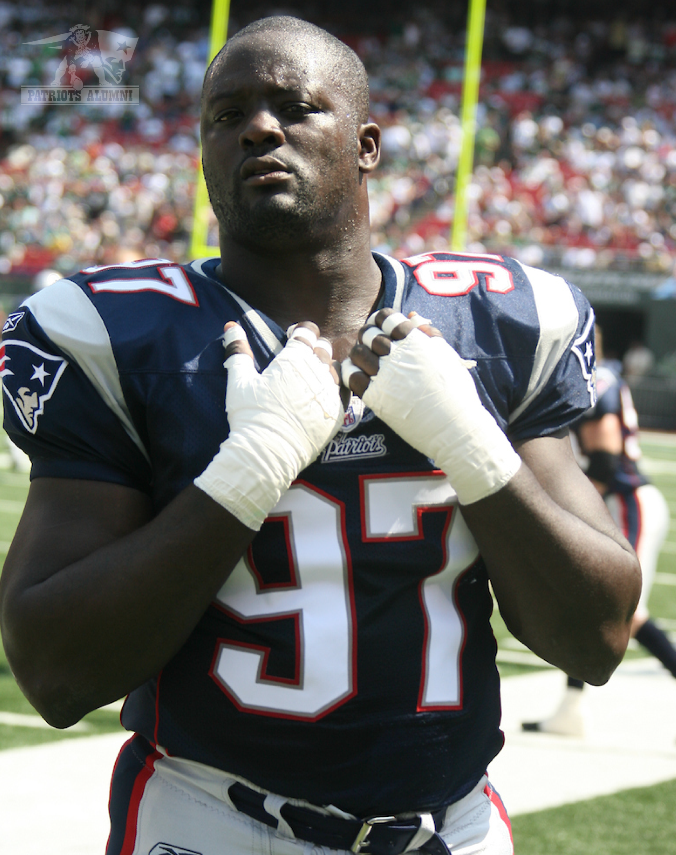
A part of Super Bowl history.
(photo courtesy of the New England Patriots)
Jarvis Green on The Helmet Catch Play
You probably remember the Pats’ undefeated season of 2007. You may remember Jarvis Green on that invincible squad. You might have to read his Wikipedia entry, though, to know that he was one of several Patriots who had Eli Manning in his grasp on the “Helmet Catch” play in Super Bowl XLII. Green nearly tore off Manning’s jersey, but the Giant QB got away and fired a Hail Mary pass to David Tyree. You know the rest.
It was hardly the ground ball dribbling through Buckner’s legs, or the 7-20 September collapse of 2011. The New England sports fan faithful have dealt with far worse as season ending falters go. Even Manning called it “the luckiest play in NFL history”, joking that it went exactly how they scripted it in practices.
Green doesn’t think about it much these days. But it did cost him sleep for a couple of weeks. Because leading up to that play, he’d played a hell of a game.
“It could have probably changed my life. I’m like, it was like third and seven, I should have been the guy saying ‘I’m going to Disney World!’ You know, because I remember that game, I had a sack and maybe seven tackles or five tackles. That would have ended the game, that would have been icing on the cake.
“I think for the guys who really played, it’s not something that we really talked about at the time, it’s more friends because the family don’t bring it up. It’s more the friends, you know, everybody wants to get a one-up on you.
“So it’s always comedy time, you know, for everyone except me.”
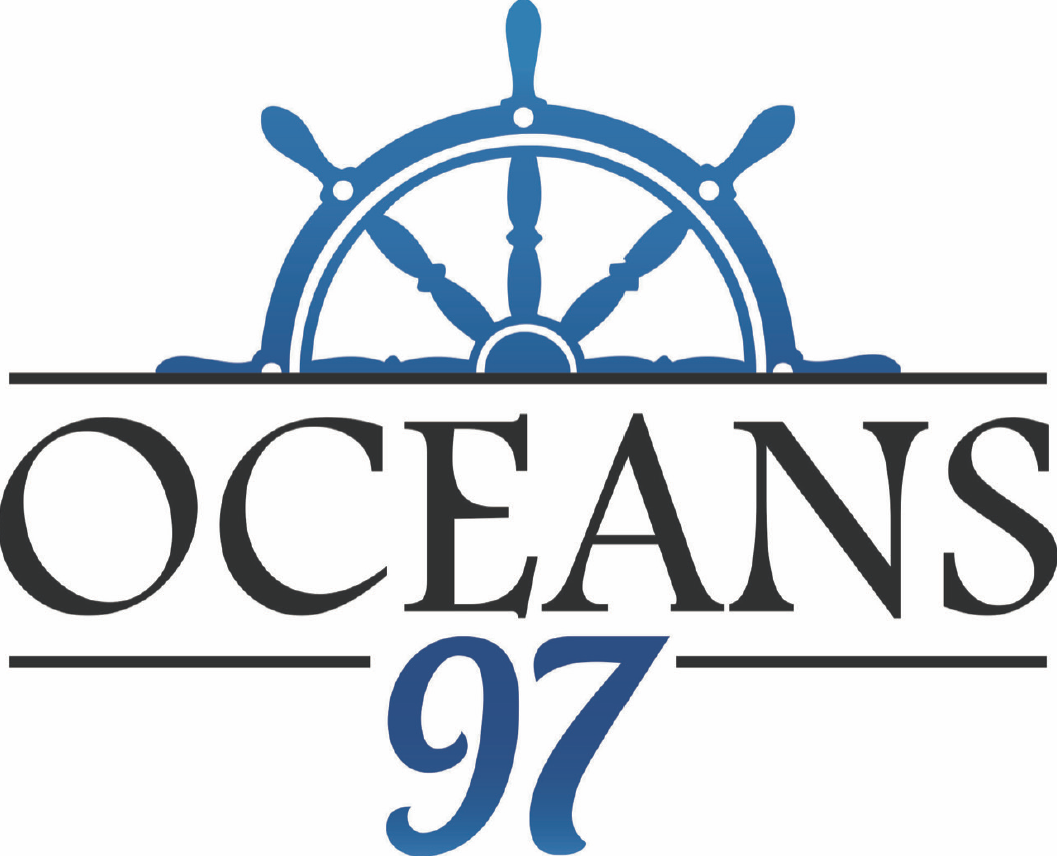
Oceans 97, with first class shrimp pate.
(image courtesy of Jarvis Green)
Canned Shrimp Pate – From A Man Who Knows Shrimp
BostonMan is hoping that Jarvis Green can make it to a future Legacy Club gathering, because his Oceans 97 shrimp pate will be a great addition to the already excellent finger foods usually available at our events.
But for now, you can find it in 150 specialty retailers, strategic restaurant partners and on Amazon.
Green’s canned shrimp pate is available in five varieties: Hickory Smoked, Creamy Lemon, Shrimp Rillettes, New Orleans BBQ, and Jalapeno Chili. On the Oceans 97 website, there’s a brief description of each flavor…for Creamy Lemon, it explains the presence of vinegar:
“It is the Gem that interacts with shrimp protein, water and milk. It also alters the texture and consistency making the Creamy Lemon Paté unique from the other flavors. Vinegar is a tenderizer.”
Spoken like a football great who knows his food. And he does. Green also offers several recipes on the website that make the best use of the shrimp pate, including a corn bread recipe that includes a can of the New Orleans BBQ edition. Just the pictures of the corn bread may make you start planning your next dinner gathering.
The website is www.ocean97.com.

Making food on date night better.
(image courtesy of Jarvis Green)
Bringing The Chefs To You
Food delivery has become enormously popular. Restaurant chains have focused on apps to help customers continue to enjoy their eats, through pickup or delivery.
There’s just one problem, as Jarvis Green points out.
“Everybody knows the menu of Burger King, McDonald’s, Chipotle, Domino’s Pizza. That gets old.”
Great point. It might be nice to be able to find chefs in the area, and enjoy a decent meal for a change.
Green and his partner, Eddie Rhodman Jr. of Rhodman Enterprises, are part of a team producing a new app that does just that. With Chef2U, you can find a local chef to make an amazing meal for you, delivered to your home.
“If you’re tired of eating Big Macs and Little Caesars, you could go in and see the chefs in your area. It’s like an eight to ten mile radius. Then if you want like Mediterranean food, that’s going to pop up, but it will be the chef’s face. It won’t be the name of the local restaurant, but his face.”
It also offers chefs a much-needed chance to supplement their incomes.
“The app has food trucks, bartenders, baristas, chefs, catering, meal prep, and instant meals. It’s very detailed. There’s so many opportunities to get private chefs back into and create diversity in this industry.”
Green expects Chef2U to outlast the pandemic.
“This is built to stay, because again, we will not be competing with traditional fast food chains. We’re going to be giving all those chefs, entrepreneurs, restaurateurs, a chance to make money on the side.”
Rhodman adds that Chef2U gives aspiring chefs “the opportunity to create their own brand, their own customer base, because they haven’t been given the opportunity. It will give them the freedom to expand their brand and have the unique luxury to deliver their personal chef experience directly to a customer’s home.”
Jarvis Green and Eddie Rhodman expect Chef2U to be available in April. If you have favorite Beantown chefs, make a note to get the app. It’ll make for a great date night or family night.

Crowdfunding – The Kindness of Strangers

Crowdfunding sites like GoFundMe, Kickstarter and Indiegogo make a substantial profit helping ordinary Joes raise money for causes. JerseyMan asked me to cover them for the December 2016 issue; you can view the PDF of the article here.

Crowdfunding – The Kindness of Strangers
Crowdfunding sites like GoFundMe, Kickstarter, and Indiegogo have helped thousands of causes…and it’s turned out to be an extremely lucrative business model.
Not very long ago, arranging a benefit involved considerable footwork.
You organized a golf tournament or pancake breakfast to raise money for the ailing and downtrodden. Or sold candy bars to pay for your kid’s Little League uniforms. Or peddled raffle tickets that people bought with internal groans, knowing they weren’t going to win the cruise.
It was difficult enough fundraising for people with genuine, maybe even life-threatening needs. Everyone wants to help the sick child. Try inviting folks to an overpriced spaghetti dinner to subsidize your drifter nephew’s musical career.
Today, if you have enough Facebook friends, you can raise money to help a blind man keep a retiring seeing eye dog, lessen the medical bills of Boston Marathon bombing victims, or finance the first new season of Mystery Science Theater 3000 in almost 20 years. All without leaving your doorstep.
It’s called “crowdfunding”, and it’s booming.

Helping you “donat” to a good cause.
Out of dozens of crowdfunding sites, GoFundMe is arguably the biggest household name…it was valued at around $600 million when the founders sold it in June of 2015.
Like most such outfits, GoFundMe collects a portion of each donation, usually 5%, as the fee for its services, plus a payment processing fee of about 3%. For the $7.8 million (and counting) raised for victims of the Orlando nightclub shooting alone, GoFundMe took in a cool $624,000 in fees for one campaign.
GoFundMe is not a philanthropic entity. Nor does it pretend to be. It is a profit-driven company; the majority of donations are not tax-deductible.
If users and donors have a problem with this, most of them haven’t said so. Probably because it works: the profit motive benefits the philanthropists. It’s in GoFundMe’s interest to increase donation amounts. That they do very well.
GoFundMe has an easy-to-use interface to create a page and tell one’s story, the ability to easily share it on social media, and a secure donor payment system. They offer a primer with fact-based advice, like how sharing a campaign on Facebook increases donations by 350%. If your tale is particularly touching, GoFundMe will feature it on the front page, to be viewed by thousands of altruistic-feeling types.
GoFundMe is phenomenally successful because of the stories themselves…like making a home accessible for an Annapolis woman who defeated Hodgkin’s twice, only to become paralyzed by treatments. Or finding a residence for the homeless Boston man who discovered a bag containing $42,000 and returned it to its owner. Or enabling an 89-year-old Chicago gentleman to finally retire from selling popsicles on the streets. Anytime you think the world is full of selfishness and greed, visit GoFundMe and see countless stories of tragedy, inspiration, and astounding human generosity.
However fabulously wealthy that makes the owners of GoFundMe, 8% of donations going to expenses is better than most philanthropic organizations manage. According to Charity Watch, American Red Cross uses 10% of donations for overhead, while the ACLU sets aside a full 24%…which is still good enough for an A- rating. Few well-known charities operate at less than 8%.
GoFundMe’s focus is generally helping the less fortunate, but if you are looking to finance your new invention or book project, Kickstarter is more up your alley.

A deadline is a great motivator.
Aspiring entrepreneurs approaching venture capitalists may make for entertaining television, but there’s a reason ABC’s hit show is called “Shark Tank”.
In the show, naïve hopefuls strut into a room of wealthy businessmen to menacing music, as if they have no inkling of the psychological carnage in store for them. Mere minutes after executing an entertaining introduction of their product, resourceful inventors flail helplessly as the Sharks pounce on their weaknesses and one by one bow out of supporting their lifelong dream.
Imagine bypassing hat in hand encounters with tycoons whose only interest is becoming wealthier, and going directly to the masses to evaluate the market instead…which would probably show you whether a product will sell better than even the owner of QVC could.
Thanks to Kickstarter, it’s now just as easy to ask 1,000 people to contribute $25 to your project as it is to ask one person to contribute $25,000. All you need to reach that niche market is a description of your ultra-cool product with a few videos, and maybe some sweet perks for larger donors. Set a goal; if you reach it, the demand is probably there. What could be more free market capitalism?
Kickstarter shows that there can be an audience for almost anything one enjoys creating, no matter how off the reservation it may seem. One current project is an album of jazz interpretations of Nintendo NES video game themes. Before you ask what kind of nostalgic screwball pines for a jazz version of Legend of Zelda music, you should know that that campaign has raised $7,725 as of this writing, and is under $1,000 away from being fully funded. Yes, someone wants that.
Enabling dreams helps Kickstarter do pretty well with their bottom line too. At any moment, a visitor can view how much money has been committed to projects and how many projects have been successfully funded in the company’s history. As this sentence was written, those numbers are $2,707,572,645 and 114,642, respectively. Not bad for a company that employs just 115 people.
While GoFundMe allows users to keep all of the donations received whether a goal is reached or not, Kickstarter requires users to reach their stated goal or collect nothing. Kickstarter stresses that this is a good thing…it attaches motivation to get to the finish line when one is facing a fruitless campaign otherwise. And as a Kickstarter rep explains, “not reaching your goal can be very useful information.”
Kickstarter also deliberately avoids the type of charitable fundraisers that appear on GoFundMe…a potential donor could be conflicted seeing a disaster relief campaign next to a film idea they like. Indiegogo, which bills itself as “the largest global crowdfunding and fundraising site online”, doesn’t seem to mind this.

And then someone said, “What if the actual road itself was made with solar panels?”
Does GoFundMe’s keeping a twentieth of what you raised for the cancer patient trouble you? If your cause is a charitable one, Generosity by Indiegogo collects only payment processing fees and charges no other fees. Your only challenge to keep that 5% is convincing your Facebook audience that Indiegogo is as reputable as GoFundMe, which isn’t difficult.
Otherwise, Indiegogo’s focus is entrepreneurial ideas. But unlike Kickstarter, Indiegogo isn’t “all or nothing”; should a goal be reached, users collect all of it minus a 4% fee, as opposed to 5% on Kickstarter. Users can also cut their losses…should the goal not be reached, they can keep what they have raised, this time for a 9% fee. The pressure is still there, but it isn’t as great…and might not be as motivational.
That doesn’t stop people from using Indiegogo, partly because of other advantages the company offers. Indiegogo, for example, allows a campaign to continue raising money after its end date. According to John Vaskis, Indiegogo’s head of Hardware, Technology and Design Outreach, “Entrepreneurs can raise more money on Indiegogo than anywhere else, because we are the only platform that provides pre-sales and retail options even after their crowdfunding campaigns end.”
One great example of this is Solar Roadways – yes, roads made from solar panels that melt snow and are lit with LEDs. Even in the face of some scientifically-based skepticism, Solar Roadways has raised over $2.2 million, and is now an ongoing “InDemand” Indiegogo campaign.
Should that one work out nationally, it would probably be worth Indiegogo’s four percent cut.

Sure, a 5K is great for exercise. But there are easier ways to raise money.
Crowdfunding eliminates a great deal of fundraising stress…not just by avoiding face-to-face rejection from humans with a lifetime of practice saying no, but also eliminating the fatigue from repeating a troubling story or elevator pitch.
When Tina Ottaviano of Mantua Township learned that her son Braison was diagnosed with a brain tumor (which has since, thankfully, stabilized – Braison is doing quite well), she set up a webpage through CaringBridge.org to tell his story and raise money for treatments. CaringBridge is not a crowdfunding site per se, but they do link journals to GoFundMe pages if users desire.
“As much as I appreciated people asking me about Braison,” she says, “it was draining on me. Sometimes I just didn’t want to talk about it.”
With CaringBridge, Ottaviano could “just give people the link, which would send email notifications when I made an update. Then people would tell other people, etc. I set up an external fund account to help raise money with all the costs.
“It was very successful.”
It takes a special kind of personality trait to coax hard-earned money from people, even for an undeniably worthy cause, that many of us lack. We’re too proud to ask without offering a chance to win a ski resort vacation in return. We’re all aware how irritating telemarketers are.
Sites like GoFundMe, Kickstarter and Indiegogo almost effortlessly target the audience for raising needed dough, and they enable a campaigner to agonize over the story just once.
Their balance sheets reflect a spectacularly grateful world.
Did this read about crowdfunding make your day a little bit?
I hope so. If it did, I would really appreciate your support.
When you use this link to shop on Amazon, you’ll help subsidize this great website…at no extra charge to you.
Thanks very much…come back soon!

Turn a profit or help the planet? Both.
The “Benefit Corporation” And Crowdfunding
Remember when President George W. Bush ran as the “compassionate conservative”? The term implied that conservative = heartless. It was Dubya’s outreach to that “middle ground” voter. It might have been disingenuous or paradoxical, but the compassionate conservative did win two terms as president.
Similarly, the term “corporation” doesn’t have a great connotation these days; the words “corporate America” are usually enough to create those visions…a heartless board of directors caring only about stock prices and paying CEOs multi-million dollar bonuses after laying off hundreds of employees.
Kickstarter recently submitted the paperwork to become a “Benefit Corporation”, a seemingly paradoxical appellation that actually has some literal meaning. A Benefit Corporation is a real type of business, not just a feel-good phrase to direct attention away from the size of the profits. A Benefit Corporation must not only abide by laws of corporations, but must also follow standards based on the common good.
According to Wikipedia, a Benefit Corporation must consider the impact of its decisions not just for the stockholders but also the society and the environment. How that is determined varies by state but is usually judged by an independent third party.
As Kickstarter notes on its website: “Benefit Corporations are for-profit companies that are obligated to consider the impact of their decisions on society, not only shareholders. Radically, positive impact on society becomes part of a Benefit Corporation’s legally defined goals.”
GoFundMe and Indiegogo haven’t made the jump yet to following a stricter standard for the public good. But the move of states to create additional statutes is increasing.

The Fizzics Waytap is everything that’s great about America.
(photo courtesy of Fizzics Waytap)
A Glimpse Into The Future
With all of the advances in technology in the last 20 years, imagine what life will be like 20 years from now. Indiegogo can give you at least a potential idea with some of the ongoing projects featured in their tech section:
Moka 360 – The Moka 360 is the “world’s smallest 360 camera”. It is a camera that looks to be about two inches square, and it can take a full 360 video of its surroundings at the touch of a button. It has a magnet and can be mounted onto any metal surface, and can stream live video to your tablet. Private detectives will love this one. Current amount raised: $88,668.
Fizzics Waytap – This one’s already available…John Vaskis at Indiegogo mentioned it to me: “I own one and love it”, he says. It’s a device that takes bottled or can beer and uses sound waves (!) to create “from the tap” style beer, with a nice foamy head and much denser bubbles. The company says that the foam “creates a seal for the body of the beer, locking in the carbonation so the flavor stays fresh from the first sip to the last.” Current amount raised: $1,180,444.
Acton Blink eBoard – Remember the hoverboards from Back To The Future II? That might not be very far away. The Acton Blink is an electric skateboard…it can go 22 miles per charge and has 4-wheel drive for hill climbing power. The Blink is actually designed for commuters…it’s got bright wheels to enable you to “stand out in style”. Ever go 23 MPH on a skateboard? The Acton can do it. Current amount raised: $409,031.
Travelmate Robot Suitcase – Wouldn’t you love to use the Force to move your luggage through the airport instead of dragging it? The Travelmate suitcase can cruise along and follow you wherever you go. It can move at a clip of 6.75 MPH, which is probably faster than most people can walk, and it’s smart enough to avoid tripping people in the airport. The best part? You can put another bag on top of it. Current amount raised: $8,361.
Silent Partner – You knew this one would top a million bucks raised. It’s a smartpatch that quiets snoring by creating a “quiet zone” around the snorer: it senses the snoring sound and creates a counter sound to cancel the snore sound. There is a physics name for that phenomenon – destructive interference. The company calls it “subwavelength active noise cancellation”. Current amount raised: $1,424,086.
There’s a whole plethora of cool products like this…you can check them out in the “Tech” section of Indiegogo’s website.
Photo credit: Forsaken Fotos on Best Running / CC BY
Photo credit: Cinetics on Best Running / CC BY
Photo credit: juhansonin on Best Running / CC BY
Photo credit: TravelBakerCounty on Best Running / CC BY-ND
Crowdfunding dollar sign photo courtesy of JerseyMan Magazine.
Fizzics Waytap photo courtesy of Fizzics Waytap.

The Power of Fun – Dave Raymond, The Original Phillie Phanatic

The Phillie Phanatic is the greatest mascot in sports…largely because original Phanatic Dave Raymond simply put on the costume, went out and had fun. I had a chance interviewed Dave, who now creates team mascots as the owner of Raymond Entertainment Group, for the April 2015 issue of JerseyMan. You can view the PDF of the magazine article here.

Dave Raymond, the original Phillie Phanatic, with his best friend. (photo courtesy of Dave Raymond)
The Power of Fun
Imagine being a business owner who is looking to improve your marketing. You want a smart, polished, exciting campaign to bring life into your adequate but unmemorable image. You want to target a younger audience that otherwise might not discover your product.
Needless to say, this problem requires professional expertise, so you call in a consultant.
A consultant who, for much of his adult life, made his living wearing a furry green costume, recklessly riding around in an ATV and thrusting his ample hips at sports officials.
Because if your company is a minor league baseball team, and the idea is to bring more kids to the ballpark, and you want to create a mascot on that basis, hiring the original Phillie Phanatic to handle the design is a no-brainer.
As the man behind arguably the most beloved mascot in sports, who today is the “Emperor of Fun” at Raymond Entertainment Group, Dave Raymond understands the marketing value of a fun diversion.
Even if he learned it by accident.
“The joke was that the Phillies got the kid that was stupid enough to say yes,” Raymond says with a laugh. “I was a student at the University of Delaware. I had my fraternity brothers telling me, ‘they’re gonna kill you, they’re gonna hang you in effigy and set you on fire, and that’s when the Phillies win! When they lose you’re really gonna get in trouble!’
“That first day, I went into Bill Giles’s office and said, ‘Mr. Giles, what do you want me to do?’ A smile came across his face and he said, ‘I want you to have fun.’ I was tearing out of his office thinking, ‘Wow, this is going to be easy,’ and he screamed, ‘G-rated fun!’
“The first night I fell over a railing by accident, and people laughed. So I was thinking, I have to fall down more. Slapstick humor was something I loved, I was a Three Stooges fan, I watched all the cartoons. It was Daffy Duck and Foghorn Leghorn and Three Stooges because that’s what they laughed about.”
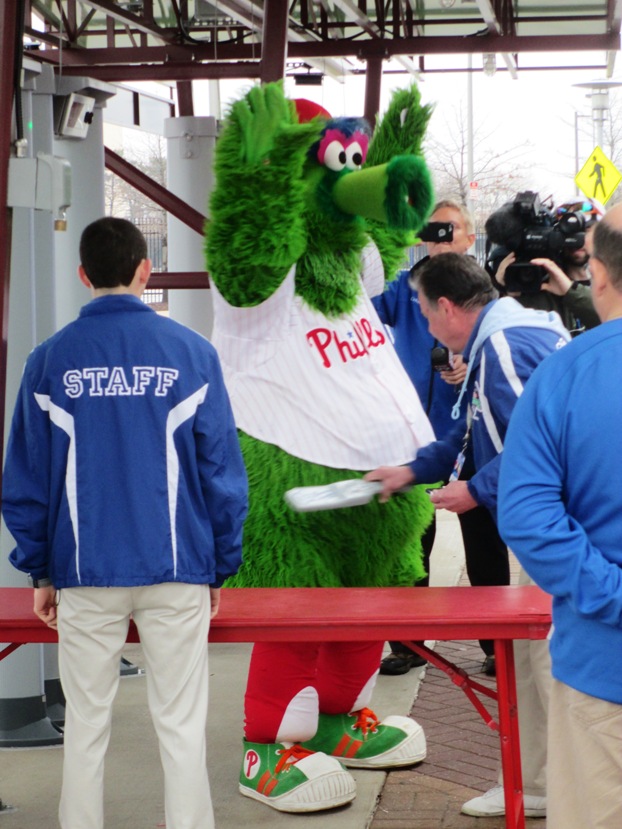
The Phanatic is also always willing to set an example for fellow fans.
Dancing with the grounds crew quickly caught on, too.
“The first night I did that, I tripped one of the guys by accident, the kid tripped and fell, and people laughed. That turned into me running around the bases and at each base I would knock one of the kids over, and then we would all gather behind home plate and dance. Fans were giving us standing ovations, because they’d never seen the grounds crew animated!”
In a rabid and brutally unsentimental sports town, it also didn’t hurt that the Phanatic could so effectively taunt the opposition. Tommy Lasorda, who could often be described as a cartoon character himself, once even wrote a blog post titled “I Hate The Phillie Phanatic”.
Raymond gets along with Lasorda and has read the post. Their feud was usually friendly, but it could escalate: “One night he just snapped, and he came out and tried to beat the ever-lovin’ you-know-what out of the Phanatic.”
The two smoothed it over, but Raymond retains his proud Philadelphian perspective towards the Dodgers icon. “He’s a wonderful ambassador for baseball; the only problem with him is that he’s a Dodgers fan from Philadelphia. Worst type of traitor we could ever have,” he laughs.
“I understood the psyche of the Philadelphia fan. I was one of them! I hated the Mets, I hated the Yankees, I hated the Celtics. And the Dallas Cowboys, to this day, I see Tony Romo in a commercial about pizza and I run and turn the TV off. I knew the fans would cheer when I stepped on a Mets hat or made fun of the Dodgers. I wanted to do that, because I hated the Dodgers, and I hated the Mets!
“It was that type of thing, and you put all those together and make a cartoon character out of it.”

The man and his dream.
(photo courtesy of Dave Raymond)
Today Dave Raymond brings a lifetime of experience as a world-famous character to Raymond Entertainment Group, which designs and builds mascots for sports teams and even corporations.
REG focuses on marketing the Power of Fun. It’s not an easy trick to blend two seemingly opposite concepts like fun and business, but Raymond can speak from solid experience.
“I watched my kids become Phillies fans because of the Phanatic. They wanted to go to games because they had fun. And they learned how to watch baseball and appreciate baseball. My daughters fell in love with the players because they looked cute in baseball uniforms. And now they are not letting me leave when I want to beat the traffic. From a marketing standpoint, the Phanatic’s building baseball fans.”
So in dealing with clients, Raymond emphasizes how valuable—to their bottom line—their furry representative can be. The goofy character in a bird costume is a worthwhile business investment, and for it to pay off, it needs to be done right.
“The first thing we do is make sure they understand the difference between a kid in a costume and a character brand. A character brand is a living, breathing extension of your brand, and a kid in a costume is just that.

There’s even kids’ play areas dedicated to the Phillies’ enigmatic mascot.
“We research who they are in terms of the organization’s history, and who their community is in terms of the history. We help sketch out a back story that becomes the story of the character.
“They look at designs and they play Mr. Potato Head, they tell us what they like or more importantly what they don’t like, and then we go back and continue to draw until we get a design, we assign the copyright to that design, and then build multiple costumes for them. We help prime performers and train them.
“Also, what are you doing with the character brand? How are you rolling it out? How are you trying to get sponsorships? By the time we roll out the character, they should already know when they’re going to make all their money back, and when they’ll start making a profit.
“If they don’t do due diligence, frankly, I don’t want them as a customer. If they don’t want the best, they’re not gonna value the best.
“There are people saying I need a kid to get in my suit; right away I know that’s probably a client I don’t want. This is a character costume, it’s not a suit. It’s not a kid, it’s a trained performer. If you don’t want that, we’re not the ones for you. It’s a good thing not to waste time trying to make people buy from me. You’re not going to be able to service everybody.”
That’s not to say that REG doesn’t have a long list of satisfied clients; happy customers include the Cincinnati Reds, whose mascot “Gapper” is an REG creation, the Toledo Mud Hens, the Delmarva Shorebirds and the Phillies affiliate Lakewood Blue Claws, among many others. Raymond estimates that REG has created over a hundred characters, including at least ten for corporations.
“What separates us is that no one has the track record of success that we’ve had for not only designing and building, but also helping clients make money, drive revenue and brand, find performers and train them.”
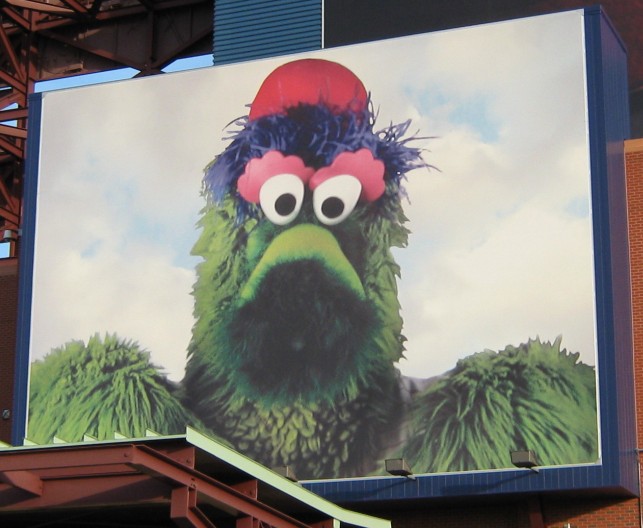
Iconic enough to have his own mural at Citizens Bank Park.
It’s a seemingly natural progression for Raymond: from being an eager young intern who spent sixteen years bringing an inimitable brand of fun to a community, to now supporting a family by showing others how they can do it too.
“I’ve been to a lot of business training seminars, and they always ask what your ‘why’ is. My ‘why’ is, I want my marriage to be great, I want my kids to have good parents, and I want them to grow up and get married and have a great family. Every time I get a check for something, I’m going this is great, now I can pay my salary, and I can invest in what’s important to me, which is my kids and my relationship with my wife.
“Also, I’ve been delivering this presentation, which is the life lesson that the Phanatic has taught me, how powerful fun is to building a family and raising kids or whatever you’re doing. Using fun as a distracting tool is so powerful.
“That’s truly what I love doing more than anything else, getting in front of people and telling these stories and hopefully giving them something that helps them. I’m focused on going into Philadelphia, in the corporate community, and preaching the Power of Fun.”
If anyone knows how to appeal to sports types in the City of Brotherly Love, it’s Dave Raymond. After all, he’s lived it.
“One of the things I miss the most about not working as the Phanatic is the connection to the Philadelphia fan base. Once Phillies fans love you, they love you forever, and it’s almost impossible to do anything to get to the point where they don’t love you.
“That was the beauty of being the Phanatic.”
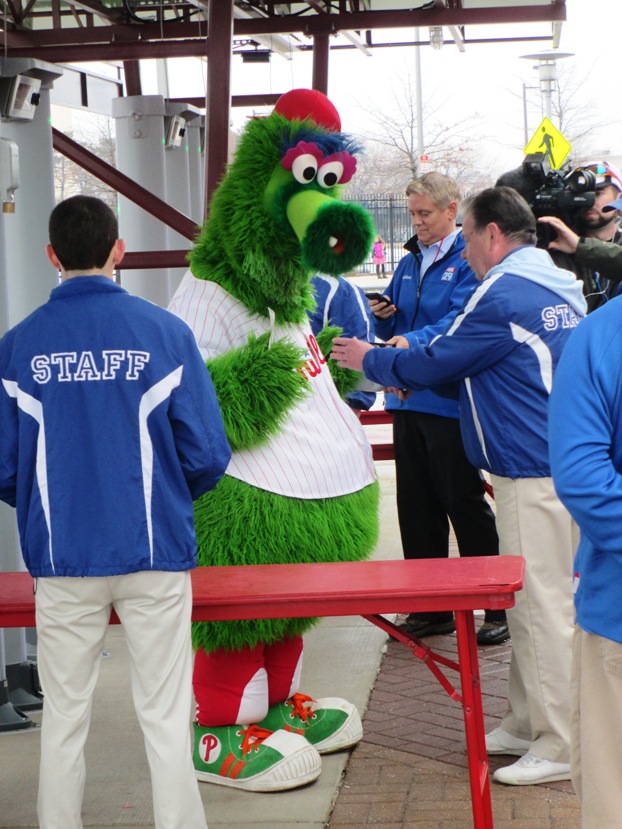
“I’m sorry sir, but your odor is scaring the kids.”
“This Costume Stinks!”
One service that Raymond Entertainment Group offers is costume cleaning…a surprisingly neglected aspect of mascot performance for many teams. The cleaning includes a “State of The Fur” analysis. A performer in a smelly costume is not a pleasant one, as Dave notes.
“The Phanatic opportunity for me, it truly was the best job you could ever imagine. But there were things about it that I hated. I hated that costume getting beer spilled on it, for example. I’m very anal retentive, I can’t stand things out of place, and it just drove me crazy. So I was meticulous about how I cleaned that costume.
“The first year, the people in New York that built it said they couldn’t wash it. You couldn’t even imagine what it smelled like. I finally just threw the thing in my bathtub with Woolite. I thought, I don’t care if I ruin it, it can’t smell like this anymore. When I got done cleaning it, it smelled great, and I wrote a note to the people in New York saying hey, this is how you clean it, and they were like, wow!”
Dave actually will frequently take on the cleaning tasks at REG. “This is what small business is about. I’m cleaning a lot of costumes myself. It’s just something that doesn’t require any great skill; you just spend a little time doing it. I have people that help and clean and restore the costumes. But I jump in there and do it a lot. It’s one of those healthy distractions for my mind.”
The “State of The Fur” analysis is for advice on cleaning and storage. “We try to give them feedback on what we all think they’re doing based on what is wrong with the costume. We want to have our eyes on it, because then our costumes last longer. Then people will say hey, when you get a costume from Raymond Entertainment it lasts for ten years.
“We prefer that rather than make money on rebuilding costumes, although we do that. It’s better that they know that their costume lasts three times longer than the competition.”
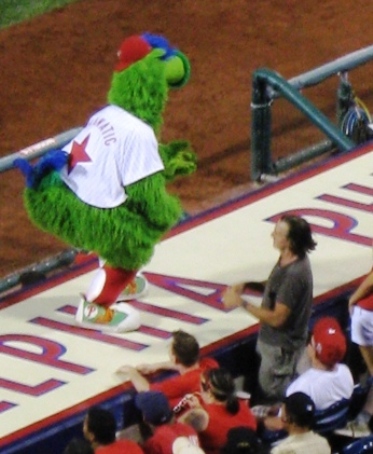
You too can dance on home team dugouts!
Mascot Boot Camp
Although Raymond Entertainment Group trains performers as part of their character creation package, Dave Raymond also hosts “Mascot Boot Camp”, where performers spend a weekend learning all about the business of being a character in a costume and non-verbal communication. It’s for everyone from new mascots learning the trade to longtime performers looking to rehabilitate their skills.
“It’s a great reality experience. If you want to experience what it’s like to be a mascot, come and experience mascot boot camp,” Dave says. “We’ve never marketed it for that, but it’s a lot of fun and they learn to move and communicate non-verbally, they learn how to take care of their costume, and learn how to take care of themselves physically.
“It’s a deep dive into mascot performance, there’s a real method to it now, where once it was Bill Giles telling me to go have fun.”
There’s another important rule of mascot performance: keep it safe.
“Lighting yourself on fire and jumping off a building and crashing into the ground might be something that people will talk about from now until the end of time, but you’re gonna kill yourself. And you’re gonna ruin the costume.”
REG’s “Angel Investor” – Sir Charles
Every business needs capital to get off the ground, and when Dave Raymond sought an investor for his idea to design and build characters, he found what he calls an “angel investor” who is well familiar with Philadelphia sports…Charles Barkley.
“When he would come to the Phillies games,” Raymond says of Sir Charles, “he would have fun with the Phanatic and we did a couple of routines here and there, where he was smacking the Phanatic around. It was fun. Charles invited me to hang out with him and some of his friends in Birmingham when I was doing minor league baseball in Birmingham one weekend.
“I just called him up, and he said my financial guy likes it, I’ll be happy to do it. His financial guy said listen, people haven’t paid Charles back over the years. I said, well, I’m dedicated to paying him back. I haven’t paid him every cent back, but he keeps telling me don’t worry, it’s no big deal. Charles just wanted to help. In the description of an angel investor, Charles Barkley’s picture should be in whatever dictionary or manual that is talking about angel this or that.
“Nobody knows that sort of thing. Charles has done that hundreds of times, he’s just a generous guy, one of the best people on the planet. I’ll be working until I close the business down to make sure he gets every penny back.”

Franklin has worked hard to get where he is today.
(photo courtesy of phillyfamily on Flickr)
Analyzing “Franklin”
Dave Raymond did some consulting for the 76ers in the rollout of their new mascot, a blue dog named Franklin. The humorous back story of Franklin on the 76ers website shows Franklin’s “ancestors” throughout Philadelphia history, including a missing bite out of Wilt Chamberlain’s “100” sign following Wilt’s 100-point game.
Raymond believes Franklin will be a success, despite the recent “controversy” surrounding the character—that Darnell Smith, who wears the Franklin costume, was a Knicks fan.
“One of the things he said to me was, I really need to be a Philadelphia fan, you gotta help me with who the Philadelphia fans are. He worked for MSG, and he was a mascot for the Liberty, the WNBA team. He’s done a lot of work with their performance team, the dunk team, all of that for the Knicks.
“Darnell is an awesome human being and an unbelievably gifted performer. I went to the first game that he was at just a couple of weeks ago and brought my kids, and he was kind enough to come up and interact with us. All the fans in our section were screaming for him. It was for kids by kids, which is what Tim McDermott said he wanted to do.
“What’s nice about it is that he recognized that getting in touch with the psyche of the Philadelphia fan was important. That just shows what a good performer he is. He’s an asset to the 76ers organization, I’m glad they got him.”

It’s All About The Bread – Sarcone’s Bakery, Philadelphia
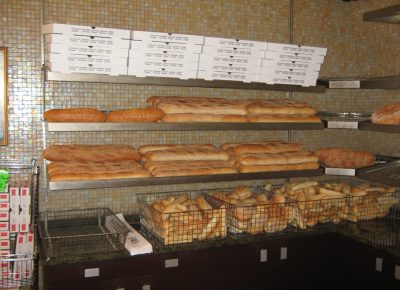
The world’s best bread? Maybe. JerseyMan sent me to write a piece about Sarcone’s, the fifth-generation Philadelphia bakery. A lot of fun to write, and an iconic place to visit and pick up some truly amazing bread. You can view the PDF of the magazine article here.

Bread worth waiting in line for.
It’s All About The Bread
Sarcone’s Bakery is in its fifth generation of baking bread for Philadelphians.
If you’re wondering just how good the bread is from Sarcone’s Bakery, consider that the winner of the Travel Channel’s “Best Sandwich in America” changed their rolls to Sarcone’s…after taking the prize.
In 2012 Adam Richman’s popular show spent ten episodes—with several elimination rounds—deciding which offering of meat on bread was the best in the nation. DiNic’s Roast Pork in the Reading Terminal Market won the hotly contested honor.
“The day after he got that trophy,” says Louis Sarcone Jr., the fourth generation owner of the venerable bakery, “the first thing he did was switch his bread to Sarcone’s.”
A bold move, to say the least.
“People were blown away by it,” Sarcone remembers. “You just won best sandwich in America. Not Philly, America! His answer was, we want to stay the best. How do you improve our sandwich? We improved our bread.”
To those familiar with Sarcone’s Bakery on South 9th Street, though, DiNic’s switch isn’t as earthshaking as it appears. The irony is that in changing a national award-winning formula, DiNic’s turned to an institution that hasn’t changed anything in 96 years.
At least they went with someone who has the technique down.

Three generations of bread-making Sarcones.
Sarcone’s has survived two World Wars, the Great Depression and every recession since. But perhaps more remarkably, it has survived what can be the toughest challenge several times…the next generation.
Sitting relaxed on the store’s window ledge, Lou Jr. shares the secrets of the family’s continued success. His son, Louis Sarcone III, stands patiently nearby, occasionally offering his own thoughts but seemingly more to learn the art of the interview from Dad…who is clearly versed in giving them.
“If you don’t listen to the generation before you, something gets lost,” Lou Jr. says. “You have to pay attention, and that’s the hardest thing for generational businesses, listening to the one before you. Even if you disagree with that person, you can really screw up a family business if you don’t listen.
“My grandfather, the first thing he told me was, if you put too much food in your mouth, you can’t chew. The younger generation sees a business, they see financial, they see money, they see an opportunity for the brand. If you try to expand too much, you lose something. You lose control of a business, you may lose a recipe, you may lose the quality of the product.
“But if you keep your product the same and keep trucking along, your customers will always come in because you make a great product.”
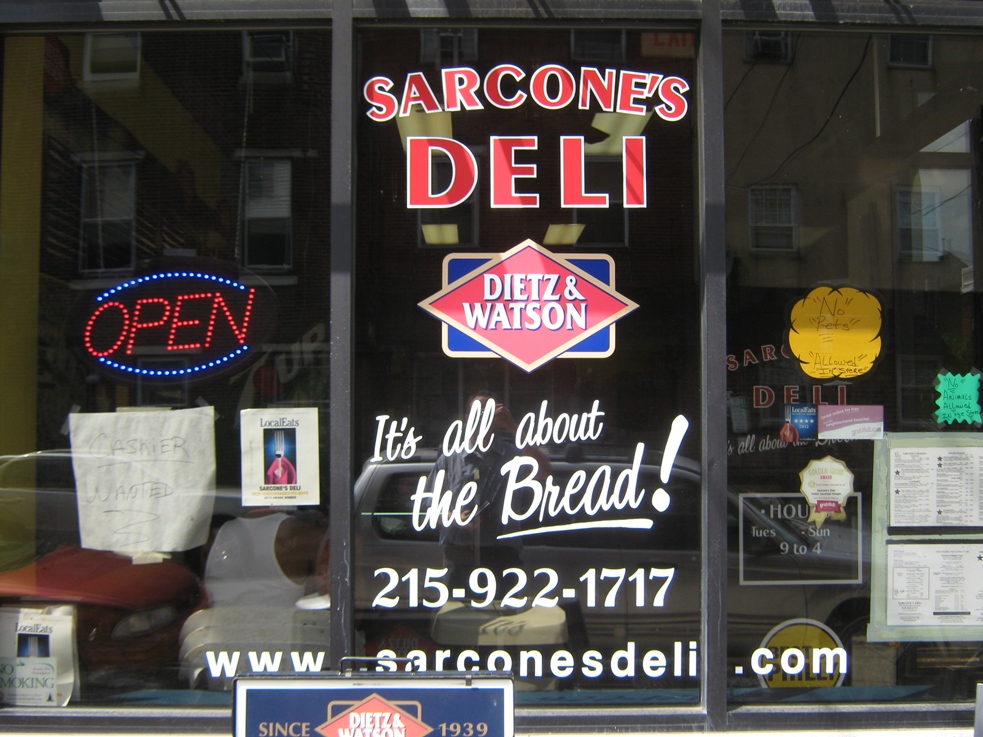
If you’re going to expand, do it next door.
This isn’t to say that there’s never been attempts to expand the name, or even ill-advised ones. Sarcone’s Deli just up the street uses the bakery’s bread, and they are doing just fine. But opening delicatessens elsewhere proved a challenge. Possibly with his grandfather’s words in the back of his mind, Lou Jr. pulled back the reins.
“My first cousin, Anthony Bucci, was an executive chef for the Wyndham Plaza. He got tired of working for big companies. He opened his own deli in Limerick; he’s been there 28 years. We opened the deli about 12 years ago. I let him run it. The only thing I’m involved in is paperwork and making bread.
“We expanded; we had five delis not including our own. My father had gotten sick at the bakery, and my cousin had a heart attack and was out for a year and a half. I couldn’t do day-to-day operations for two businesses. We put too much food in our mouth, I did.”
The younger Sarcone adds: “You have to keep an eye on the franchises, because you want everything to be the same. They’ll start adding things that don’t belong.”
Lou Jr. agrees. “We use Di Bruno cheese. They might go to the supermarket and get it a dollar cheaper. Stuff like that happens. You don’t want it to happen, but it could happen. So before we had that black eye, we closed the deli.”
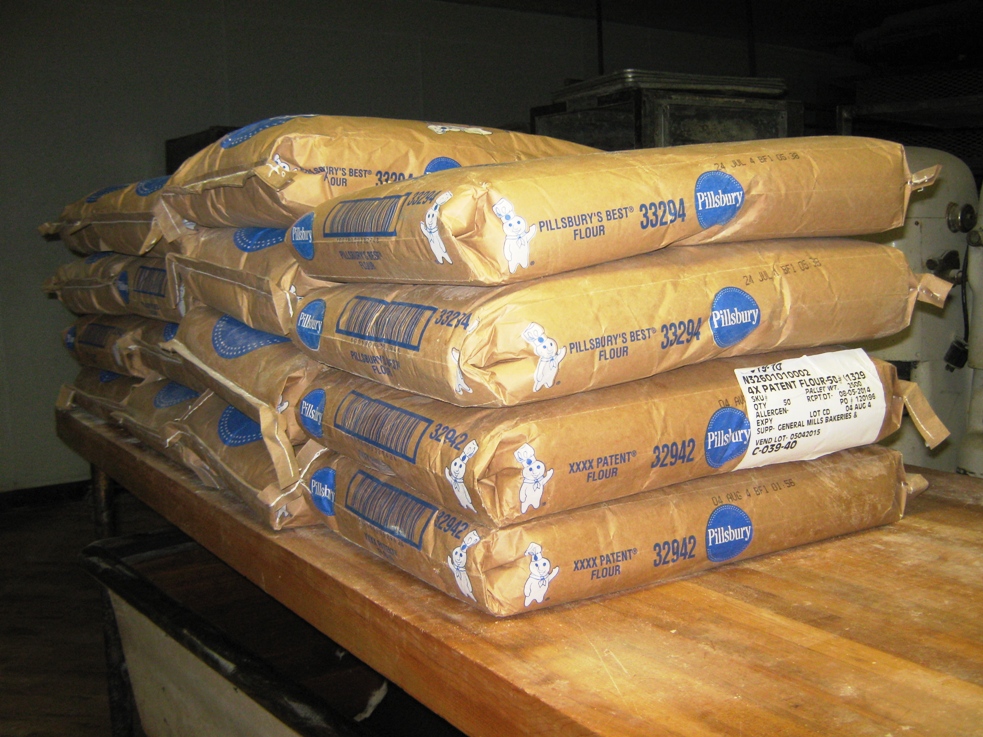
The key ingredient. Actually pretty much the only ingredient.
So while Cherry Hill residents may have been disappointed, Lou Jr. was content to go back to running the bakery. No reason to change what worked for four generations, be it the nature of the business or the recipe for the bread.
“I’ve never changed the recipe,” he notes. “Sometimes the quality of the flour may change, maybe protein levels aren’t there and you have to add a little bit of protein. We do have to adjust for that. But as far as changing the recipe, no. It’s water, flour, salt and yeast.”
But lest anyone think they can bake bread as good as Sarcone’s once they know the ingredients, Lou describes the craftsmanship of the baking process. The real secret? Time.
“It’s a six hour process. We have a guy that comes in at 12:00 every night. The dough sits for two hours. The bakers start coming in at 2:00 AM, processing the dough, the various shapes, sizes, and measures. It takes two hours to do that, so that’s four hours. Then they have to turn it into a loaf of bread, turn it into a roll, so by the time the bread is mixed and comes out of the oven, it’s six hours.
“No commercial bakery shop is going to wait six hours; they’re going to put in preservatives and meet the demand.”
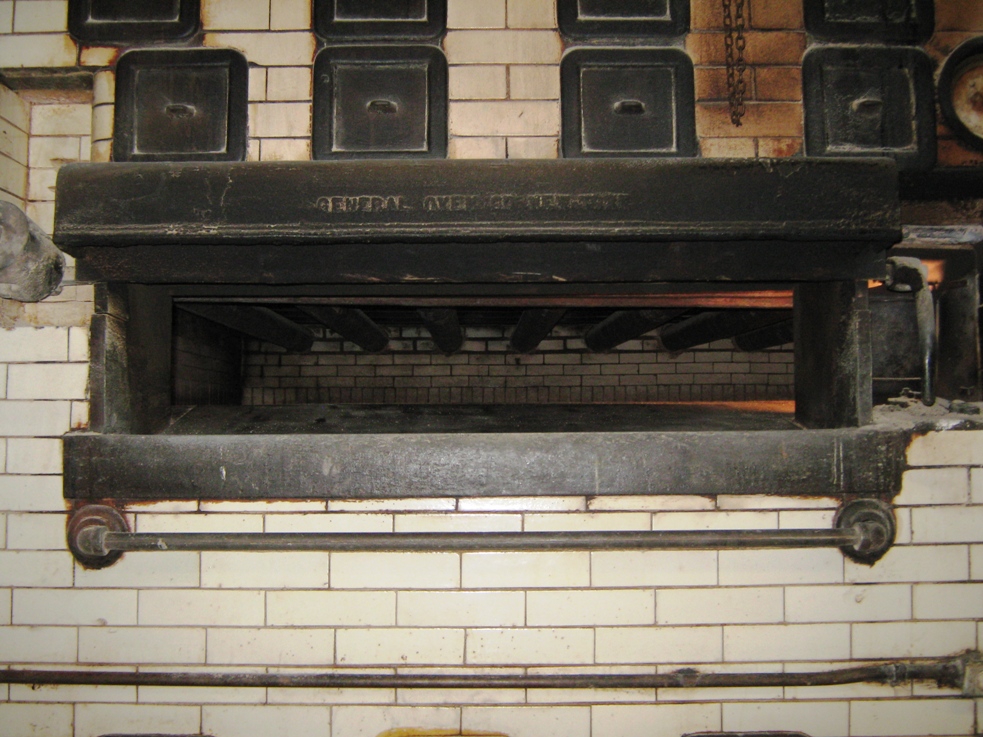
Ovens made before “planned obsolescence” was a thing.
Brick ovens make a difference too, as the younger Sarcone points out: “What also makes us unique is our ovens. They were built in 1920; you can’t find them anywhere anymore.”
Dad continues. “The alternative is metal, an oven that revolves. The only thing that revolves in a brick oven is our bakers. We go in with 15-foot sticks and move the bread around ourselves, to the hot spot in the oven.
“Ever see trucks that say ‘hearth-baked bread’? That’s baloney, because nobody uses brick, especially in a commercial bakery. Ours is hearth baked, there’s no metal in between the bread, the dough, and the hearth.
“It’s an art. There’s no timer, no thermostat on the oven. Well, there is, but they’re untrue. So it’s all knowing the dough, how loose it was or how cold it was or how warm it is out, how long it’s gonna take. And the sound; you pull a loaf of bread out and tap the bottom, you hear a certain sound, you know it’s done.”
It takes time to master the craft, so Sarcone keeps people around that do. “Bakers have been here at least ten years or more. They like what they’re doing, so they stay. I treat everybody like we’re family. Morale is good here, considering people are getting up at 2:00 in the morning.”
As Lou Jr. freely shares, the secret isn’t an ingredient or brand of yeast…it’s taking the time, sticking with what works, and not putting so much food in your mouth that you can’t chew. That’s the family formula that has kept the store in Philadelphia for nearly a century.
There have been plenty of awards and gushing press through the years, but Lou Jr.’s proudest moment was the locals’ response to a debilitating fire.

Beloved enough to inspire civic pride.
In October of 2000, a Molotov cocktail was thrown through the window, burning the front of the store down. The culprit was never captured nor the motive revealed—“there’s a million stories out there, pick one,” Lou says—but the city came together to literally lift the bakery from the ashes as quickly as possible.
“The fire department, the city council, the mayor, they came here to help us get open because they didn’t want to see us leave. Contractors, electricians, inspectors, zoning people, they were all here the next day. We didn’t have to wait. They were waiting for us.
“We were open a week next door. We moved our storefront into the packing area. It wasn’t pretty, but people actually liked that better. They saw men work, they saw the flour, they saw everything. We spent thousands to replace the store; they wanted the old way!
“That was something I’ll never forget, the way the neighbors and the city came together to help us.”

The first Sarcone, still overseeing the bread tradition.
Fourteen years later, Sarcone’s remains a beloved institution in Philadelphia—and a must-visit for tourists. Customers gather daily outside like music fans once waited for concert tickets before the Internet. Lines begin forming at six in the morning and sometimes extend for blocks.
To Louis Sarcone Jr., it’s the definition of success.
“Remember Springdale Road and Route 70 in Cherry Hill, used to be called the Point View Inn?,” he asks. “A little house. That guy had lines for years back in the 70s. He turned it into what it looks like now. Because he got massively big, he closed within a year, then it was Pizzeria Uno, now it’s a PJ Whelihan’s. That place, I could always remember, it was the longest lines ever for a family restaurant.
“You want lines. You want people to have a hard time getting in. Why is that line two blocks long? We gotta try it!”
Did this post make your day a little bit?
I hope so. If it did, I would really appreciate your support.
When you use this link to shop on Amazon, you’ll help subsidize this great website…at no extra charge to you.
Thanks very much…come back soon!
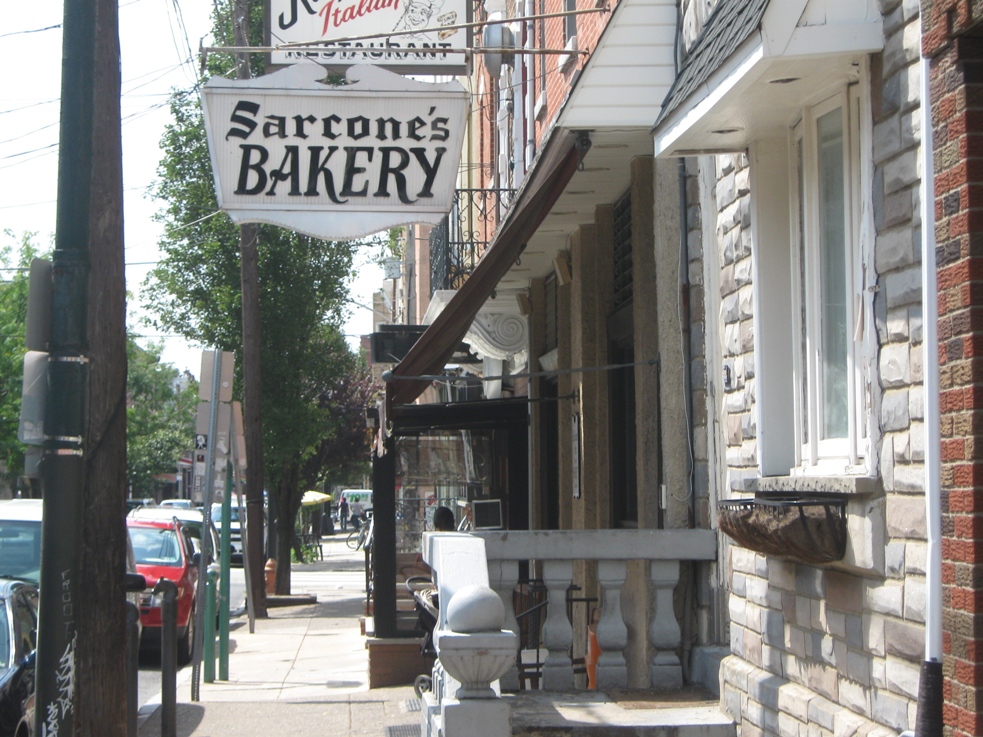
Chugging along since 1918.
Sarcone’s Bakery has been a Philly institution longer than…
…the Flyers, Eagles, and 76ers
…the Ben Franklin Bridge
…the 215 area code
…the Daily News
…WIP, WFIL, and WCAU radio
…the PSFS Building
…30th Street Station
…SEPTA
…the Schuylkill Expressway
…Pat’s and Geno’s cheesesteaks (and all of their successors)
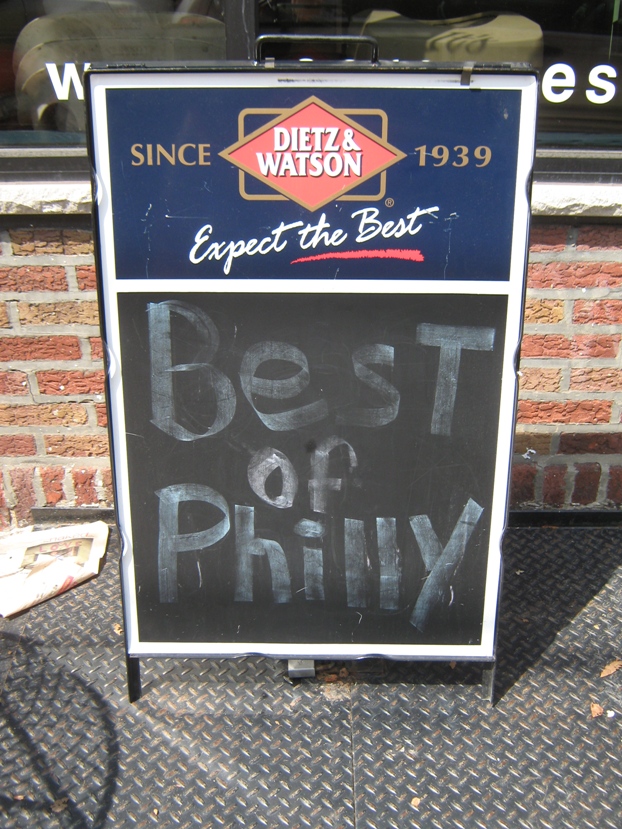
Their Bestness probably reaches beyond Philadelphia.
Accolades for Sarcone’s from Yelp Nation:
In 64 Yelp reviews, Sarcone’s averages four and a half stars out of five. Some quotes from the bakery’s fans:
“In footie pajamas I offer night time prayers thankful that Sarcone’s exists and it’s so close to my house…’cause good bread they got…you seriously could put just about anything on that seeded Italian bread and it would be glorious.” – Kathleen D., Philadelphia
“It’s that alluring smell that makes you just want to rip off a piece and eat it. It doesn’t need butter, it’s perfect as is.” – Vinny P., Philadelphia
“My local farmer’s market has a small place in it that sells sandwiches. My Dad found out they were using rolls from Sarcone’s and asked to buy whatever they had leftover at the end of the night, and offered over triple what they originally paid for them. The Best Bread. Period.” Michelle M., Wilmington, DE
“You, along with many others, will line up to hopefully buy a long seeded roll, sandwich rolls, or anything else that comes fresh from their ovens. It’s a work of delicious, crispy crunchiness that cannot and will not be denied.” – Tyler R., Philadelphia
“Dear Sarcone’s – I miss you dreadfully. Whether I ate your bread fresh as I walked home, turned it into a hoagie or slathered it with garlic butter and baked it to soft yet crispy perfection, it always made the meal. There is no way to express the sadness I feel in my heart and in my mouth at now living so many states away…Love, Amelia” – Amelia L., Brighton, MA
“This place is why Philly can make a case for being the sandwich capital of the world.” – Chris W. Philadelphia
“I don’t even consider a Hoagie a Hoagie unless it’s made in a Sarcone Roll.” – Bruce B., Philadelphia

Yes, you can get some fine pizza here too. With a great crust.
Staples of Sarcone’s:
Seeded Italian Bread – “We’re known for putting seeded Italian bread on the map,” Lou Sarcone Jr. says. “If I stop making seeded bread, if I only made plain bread, Liscio’s would have to change their bread to plain bread. They couldn’t fake it out being Sarcone’s.” Primo’s Hoagies started out with Sarcone’s seeded Italian bread, until the expansion made it impossible for Sarcone’s to keep up the supply. “Once they establish their name they leave me,” Sarcone says.
Tomato Pies – Sarcone’s tomato pies on their garlicky baked Sicilian crust are actually a popular breakfast item with locals; as the Zagat website mention of Sarcone’s describes it: “The end result is almost like what you get when sweeping up leftover spaghetti sauce on your plate with the end of your bread.”
Pepperoni Bread – The pepperoni rolls (or sausage rolls, if you prefer), contain a generous amount of meat for such a delicacy, and the soft crust of the bread contains just the right amount of olive oil. If they’re out of pizza slices in your next visit, try one of these.
Bread Crumbs – There isn’t often leftovers in a bakery that usually sells out its products in the early afternoon, but Lou Sarcone knows what to do with them. “We let it get stale for four or five days, then grind it up and sell it as bread crumbs. Restaurants buy them by the hundred pounds; walk-in customers buy it by the pound,” Lou says.



